How to Build Conditional Logic Forms + 5 Examples
Implementing conditional logic is one of the most common ways to make our form tools more effective. On the one hand, conditionality enhances user experiences. More importantly, though, it helps us to gather the right information - even when this varies from case to case.
Today, weŌĆÖre checking out how ║┌┴Žš²─▄┴┐ makes building conditional logic forms a breeze.
Specifically, weŌĆÖre going to look at how we can build five of the most common use cases for conditional forms using our open-source, low-code platform.
Even better, ║┌┴Žš²─▄┴┐ empowers teams to build advanced forms on top of just about any kind of data - whether itŌĆÖs an API, RDMBS, NoSQL tool, spreadsheet, or our built-in database. So, we can apply the same principles to an almost limitless range of forms.
LetŌĆÖs jump right in.
What are conditional logic forms?
Conditional logic means applying rules to determine how our app behaves. Most conditionality rules follow an ŌĆ£if/thenŌĆØ structure. So, if a particular condition is met, then something defined happens.
As you know, today, weŌĆÖre specifically interested in how we can apply this principle to forms.
There are two broad types of conditional logic forms we need to consider:
- Forms where conditions affect the design and UI.
- Forms where conditions affect the functionality.
In other words, we can use conditional logic to control how our form looks - or what happens when users interact with it.
The most common example of conditional forms is whatŌĆÖs called ŌĆ£branching logicŌĆØ.
Basically, this is when a form displays different fields to a user based on their previous answers.
With most traditional form builder tools, this is the limit of what can be achieved using conditional logic.
With ║┌┴Žš²─▄┴┐, we can achieve so much more. You might also like our guide to web application development .
How to build forms with conditional logic
Before we dive into some practical examples, itŌĆÖs worth going a bit deeper into the two key elements of a conditional form. That is, the condition itself and what we want our form to do when this is met.
Conditions
Conditions are the ŌĆ£ifŌĆØ part of our ŌĆ£if/thenŌĆØ statements. In computing terms, this is a statement that we define and then evaluate. If this evaluates to true, then weŌĆÖll carry out whichever action weŌĆÖve set.
In the case of conditional logic forms, this can be based on a number of different kinds of variables, including:
- Responses to the form itself.
- User attributes.
- Access control rules.
- Contextual factors.
- System variables and other more advanced conditions.
We might even build very complex rules based on a combination of these factors.
In ║┌┴Žš²─▄┴┐, each form component has its own dedicated configuration section for building conditionality rules.

To create a condition, we need three things:
- A reference value,
- An operator,
- A comparison value.
So, we might have an expression along the lines of If X equals YŌĆ” or If A is greater than B...
With ║┌┴Žš²─▄┴┐, we have two ways of setting reference and comparison values:
- Providing static values as regular text expressions.
- Creating dynamic values by adding bindable JavaScript or Handlebars expressions.
When we bind values, we can access a range of variables relating to the current user, their device, the environment, user roles, system variables, and values from any data source a particular component is exposed to:
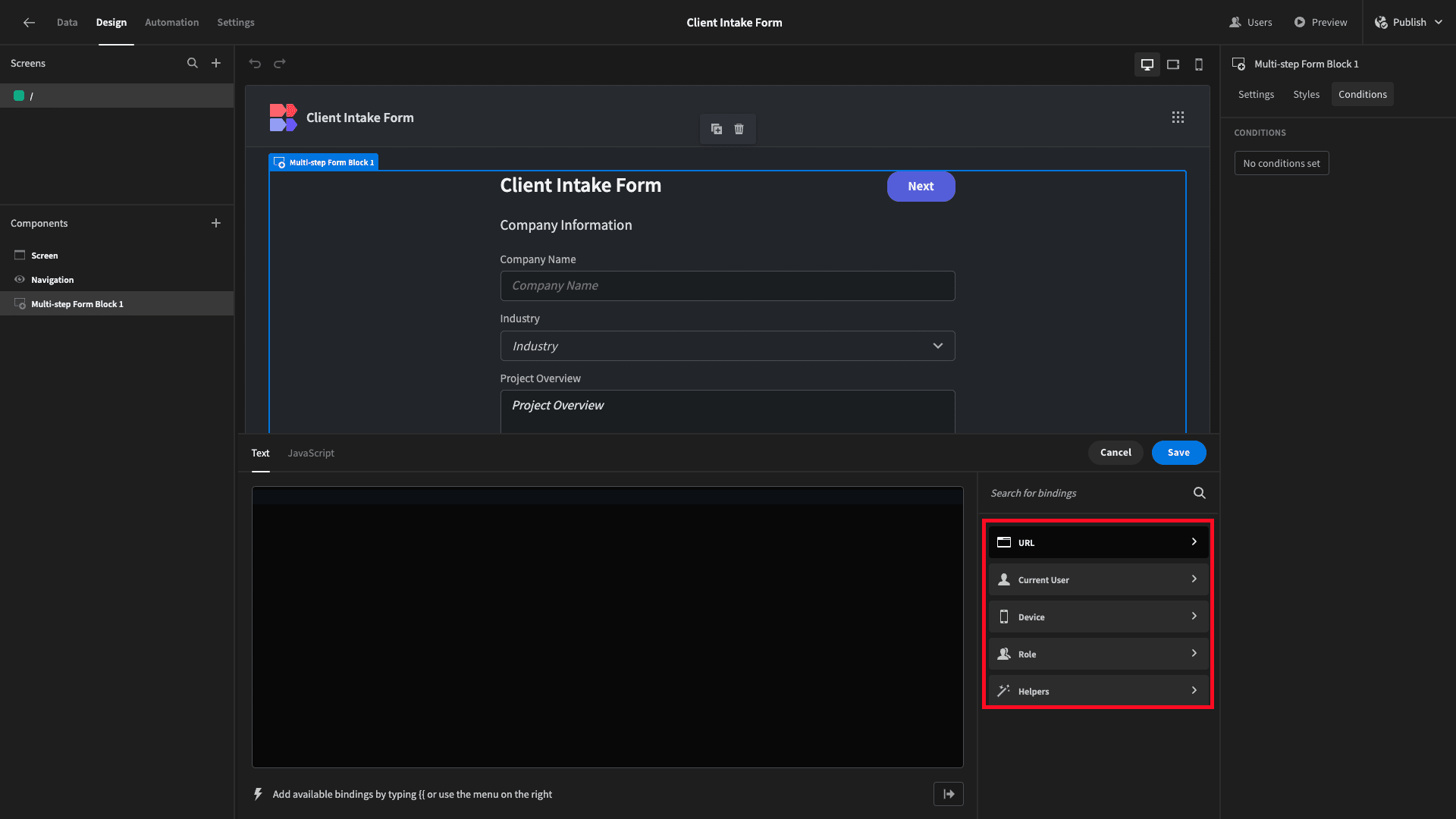
We can either use these as they are or within more complex custom expressions.
Outcomes
Outcomes are what we do when our condition evaluates to true. Within ║┌┴Žš²─▄┴┐, we have three options here:
- Hiding the component,
- Displaying the component,
- Updating a component setting.
The first two are fairly self-explanatory.
We can use conditionality rules to update any setting thatŌĆÖs configurable for a particular type of component - including design and functionality.
For example, with individual form fields, we can update their default text or the space they occupy on the screen. For buttons, we can update the actions that are carried out when pressed - or simply update their color.
Within ║┌┴Žš²─▄┴┐, we can select from these various options using simple dropdown selectors:

Building 5 types of conditional forms in ║┌┴Žš²─▄┴┐
Now that weŌĆÖve seen the basics of how we can build conditional logic forms in ║┌┴Žš²─▄┴┐ letŌĆÖs apply this to some real-world use cases.
Specifically, weŌĆÖre going to focus on five of the most illustrative kinds of conditions we can create.
Join 200,000 teams building workflow apps with ║┌┴Žš²─▄┴┐
Here goes!
1. Rules based on other form fields
The type of conditionality youŌĆÖre most likely familiar with already involves dynamically displaying certain form fields based on a userŌĆÖs other answers.
For example, our form might contain fields that are only applicable in certain situations. If they arenŌĆÖt applicable, we want to hide them for the sleekest possible UX.
LetŌĆÖs check out an example of how weŌĆÖd achieve this in the real world.
WeŌĆÖve got a form for inputting a new employeeŌĆÖs information:
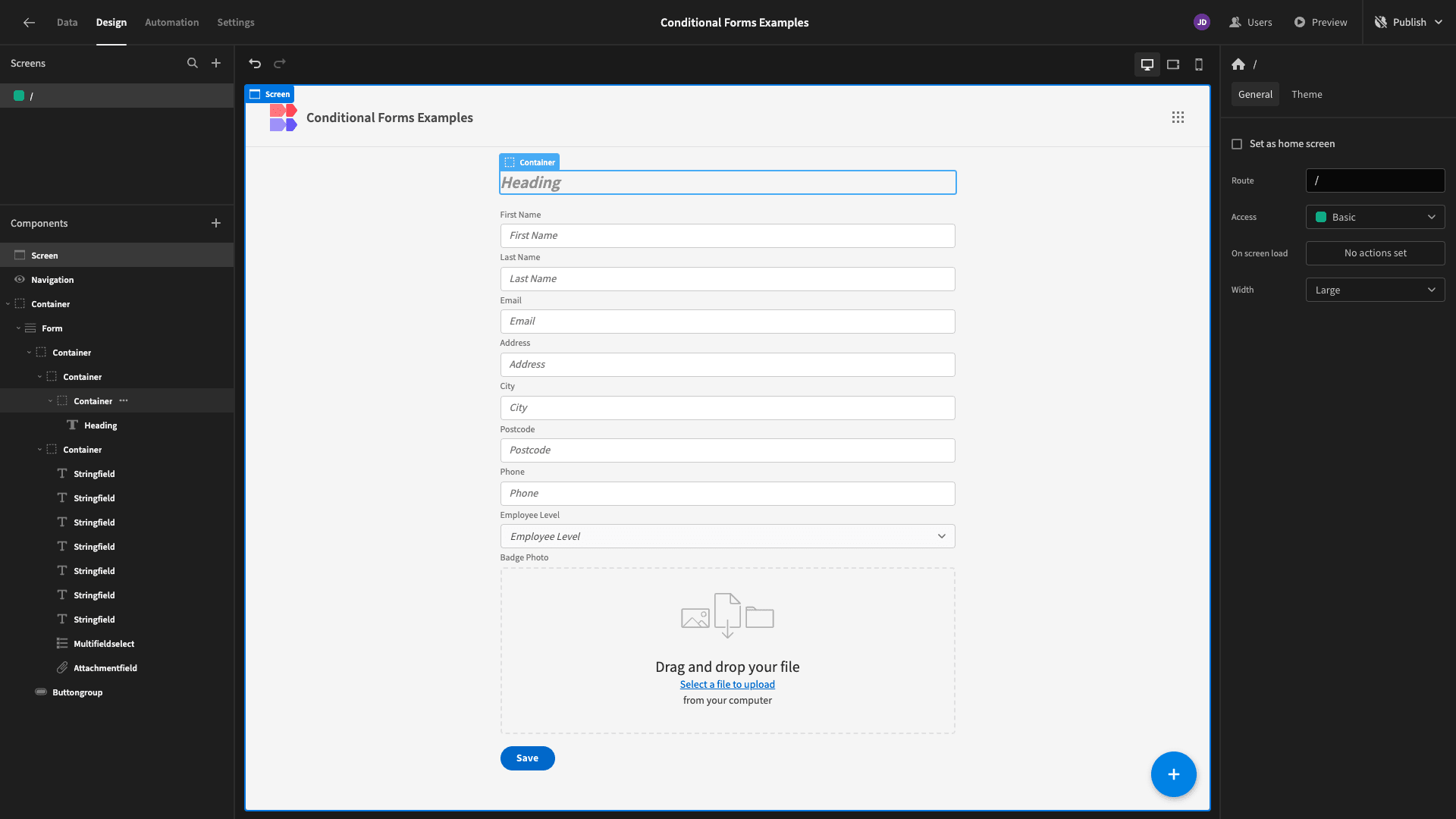
The last two fields are an options picker called Employee Level and a file upload field called Badge Photo. The options for Employee Level are Apprentice, Contractor, Junior, Manager, and Senior.
LetŌĆÖs say our internal policy is that we donŌĆÖt put photos on apprenticeŌĆÖs badges since theyŌĆÖre only temporary employees. So, we want to create some conditional logic to hide the Badge Photo field for apprentices.
WeŌĆÖll start by selecting this field and opening the bindings drawer:
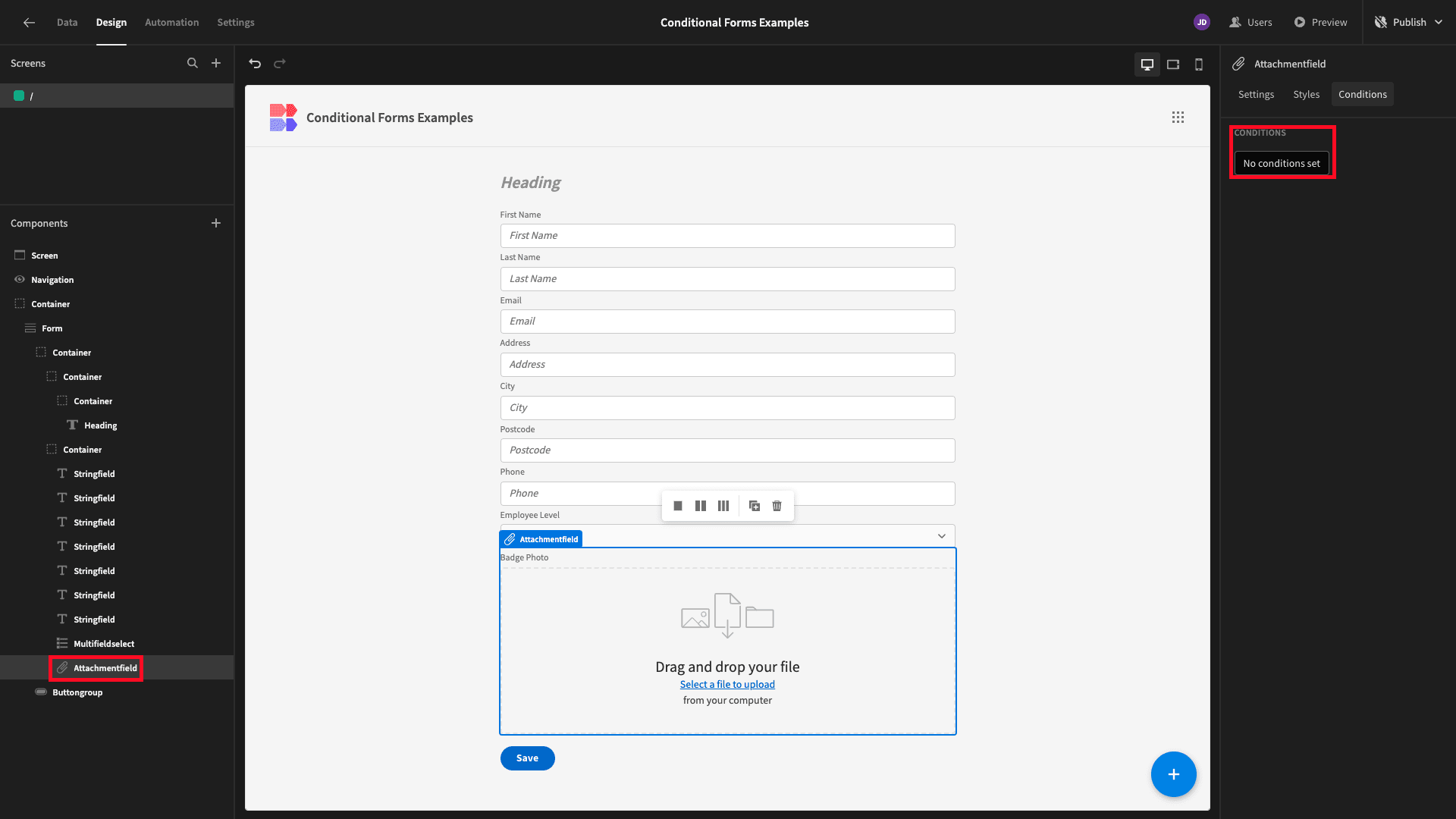
HereŌĆÖs what this looks like.
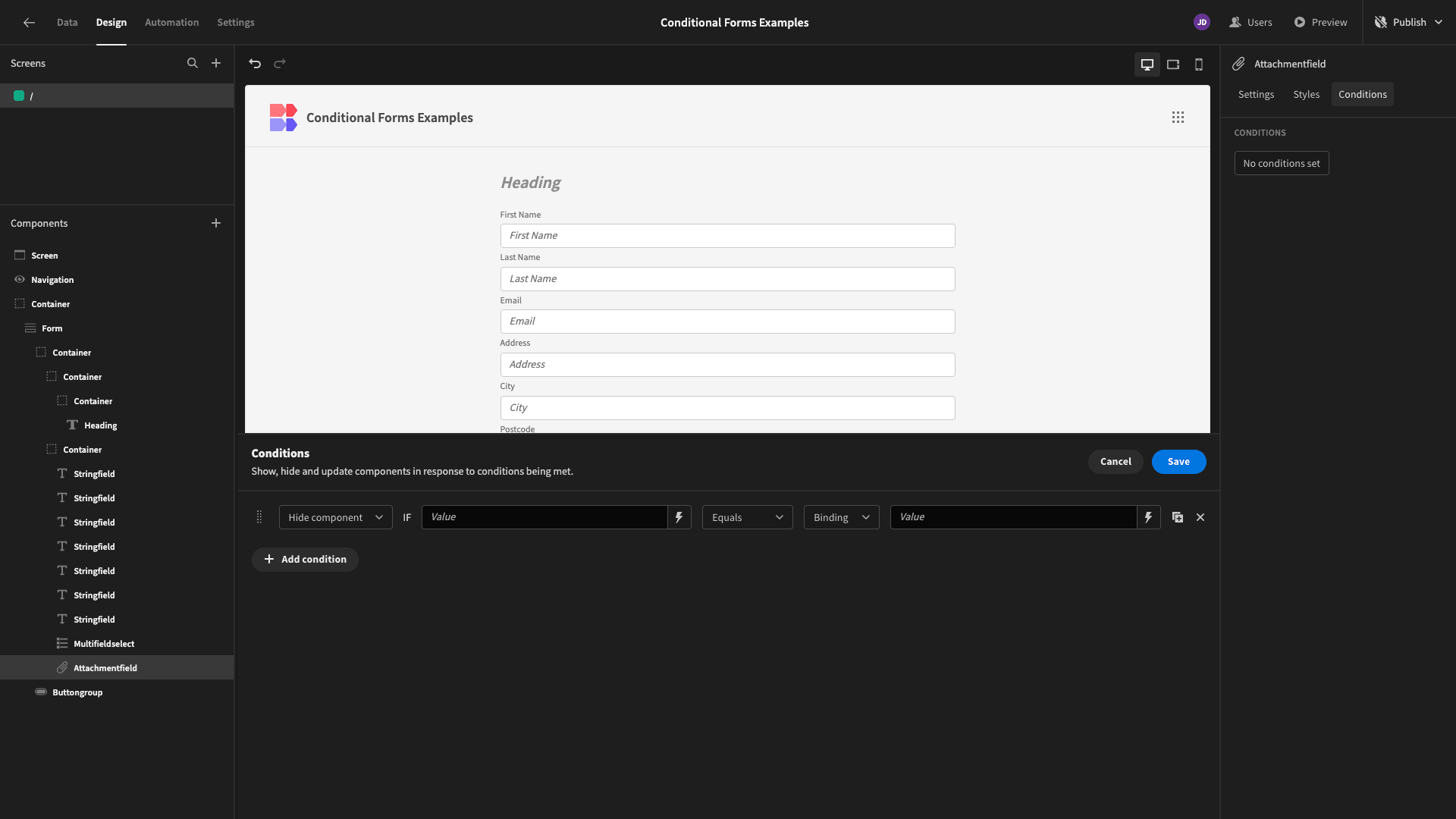
WeŌĆÖll open the bindings drawer for our reference value:
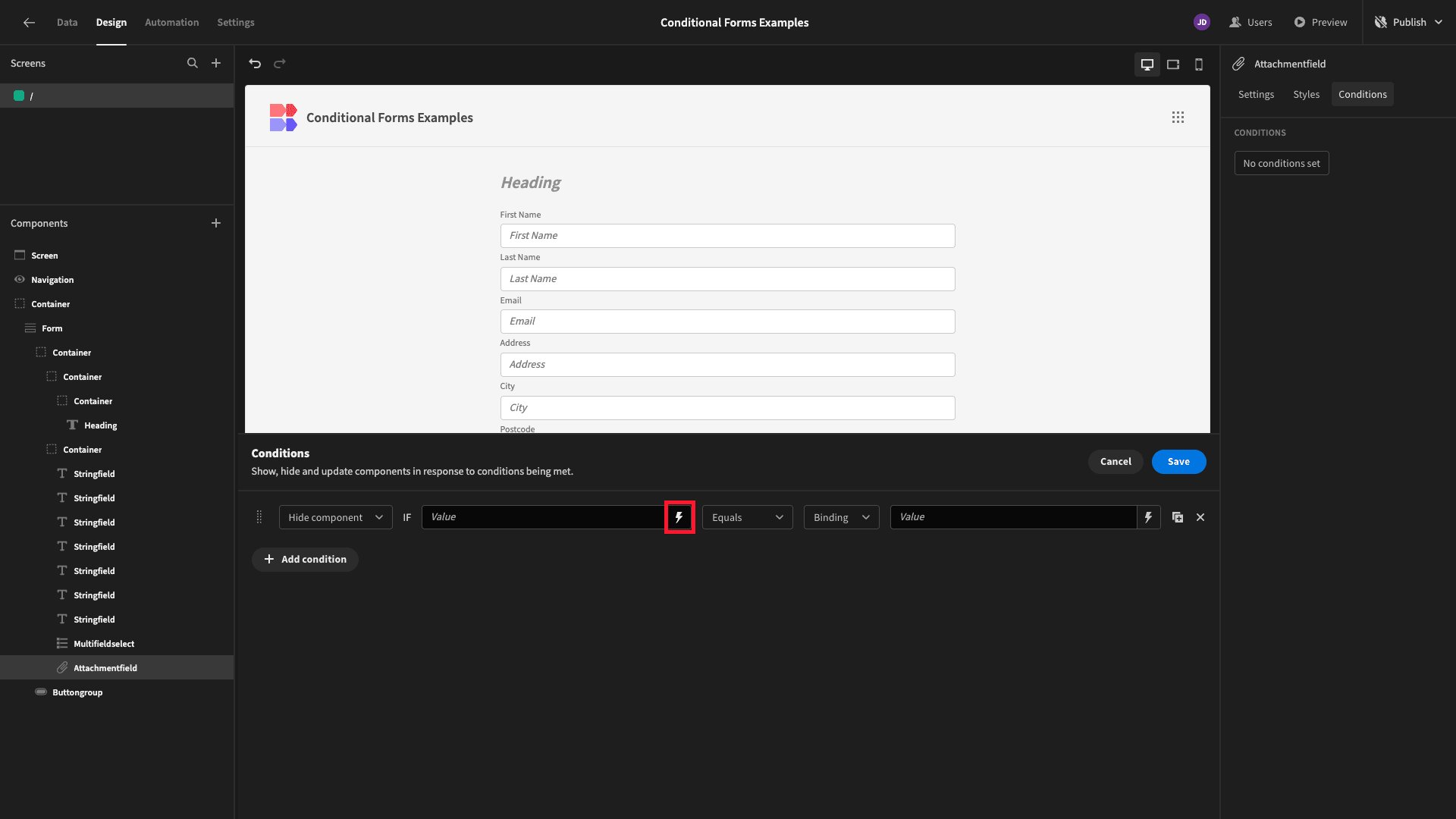
We want to build our rule around a userŌĆÖs previous answer - so we can find this under Form:
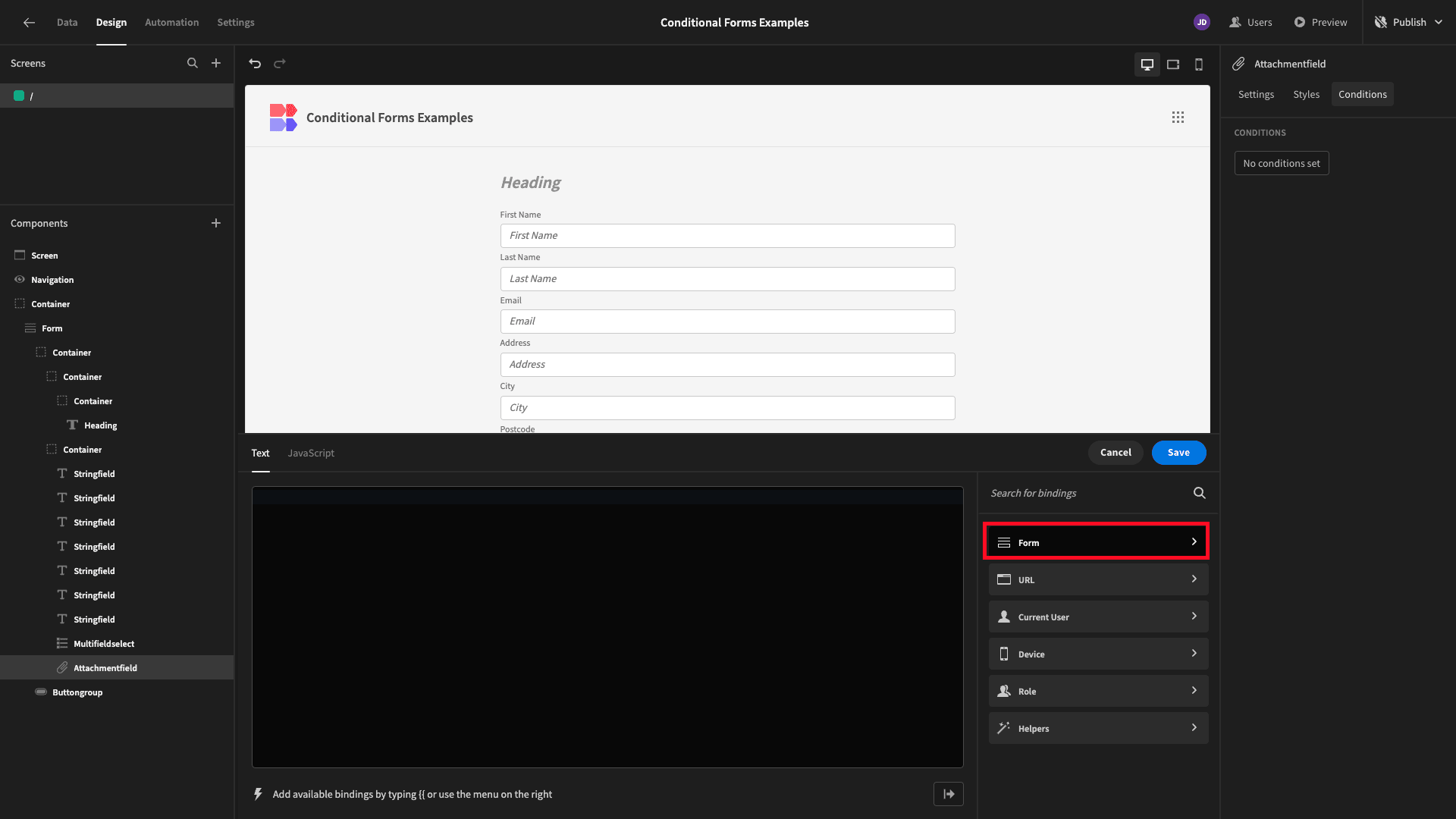
And weŌĆÖll select Employee Level.
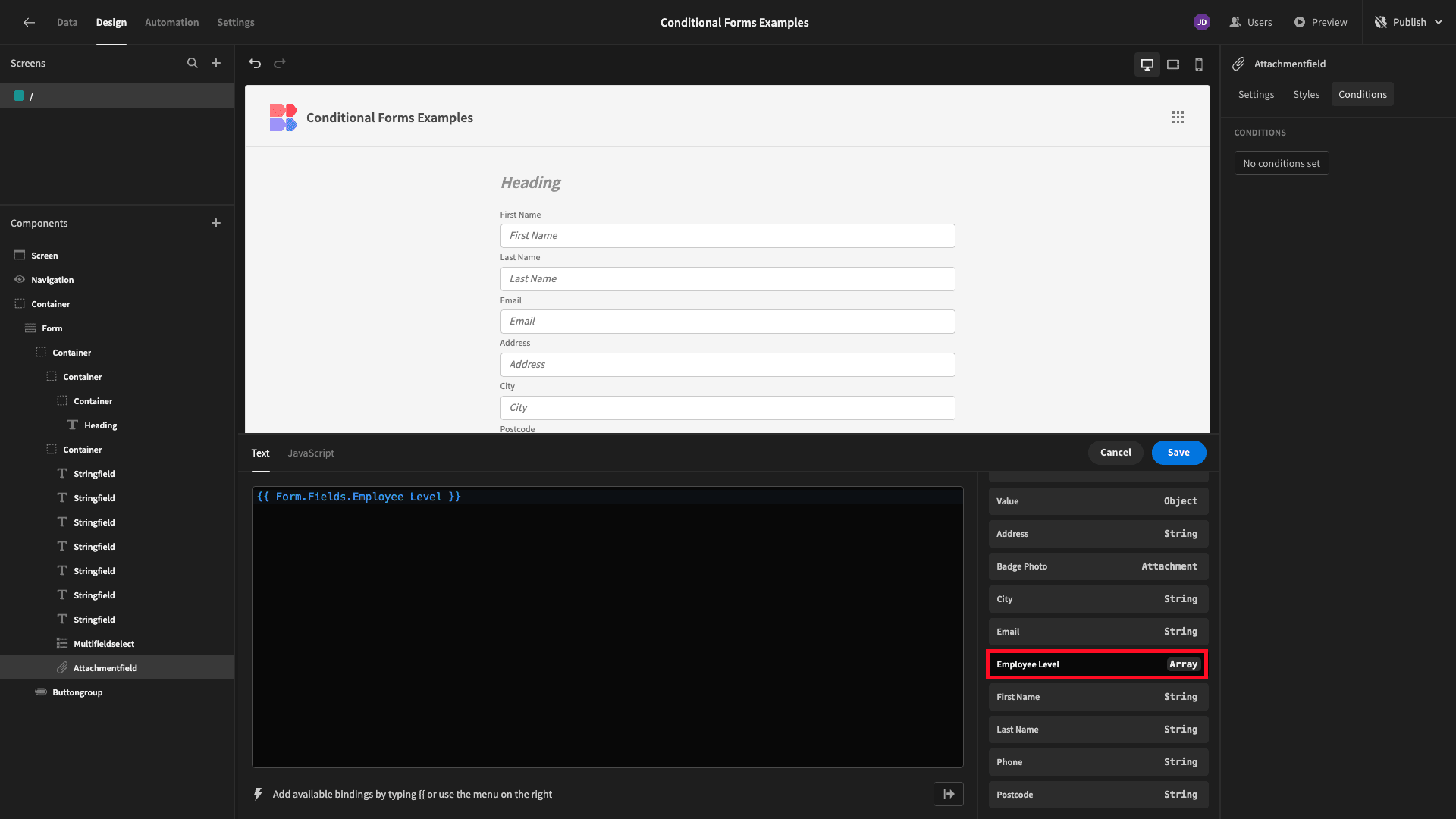
Lastly, for our comparison value, weŌĆÖll simply enter Apprentice as plain text.
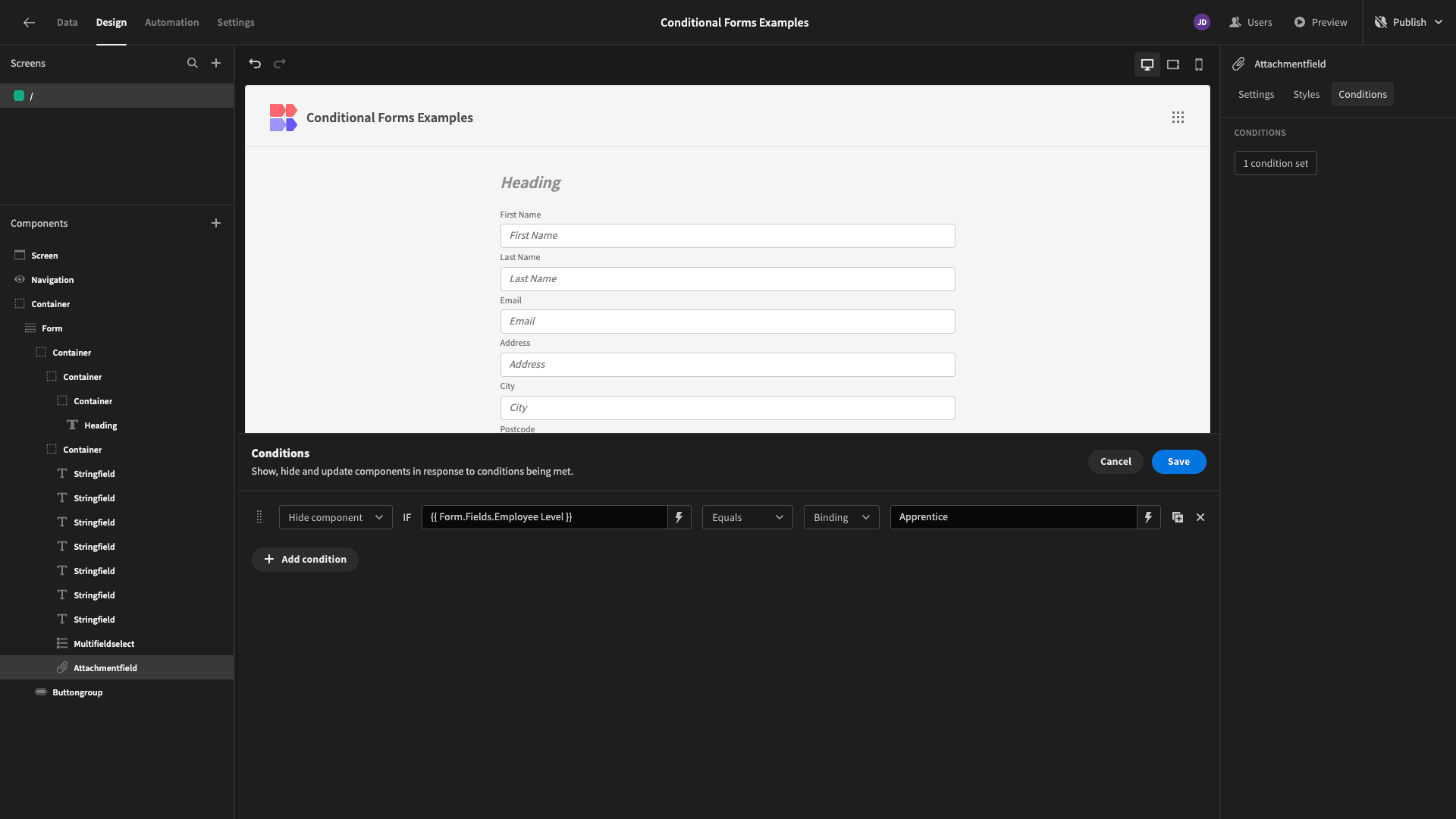
Just like that, we have a dynamic form where the Employee Level will disappear if our new colleague is an apprentice:
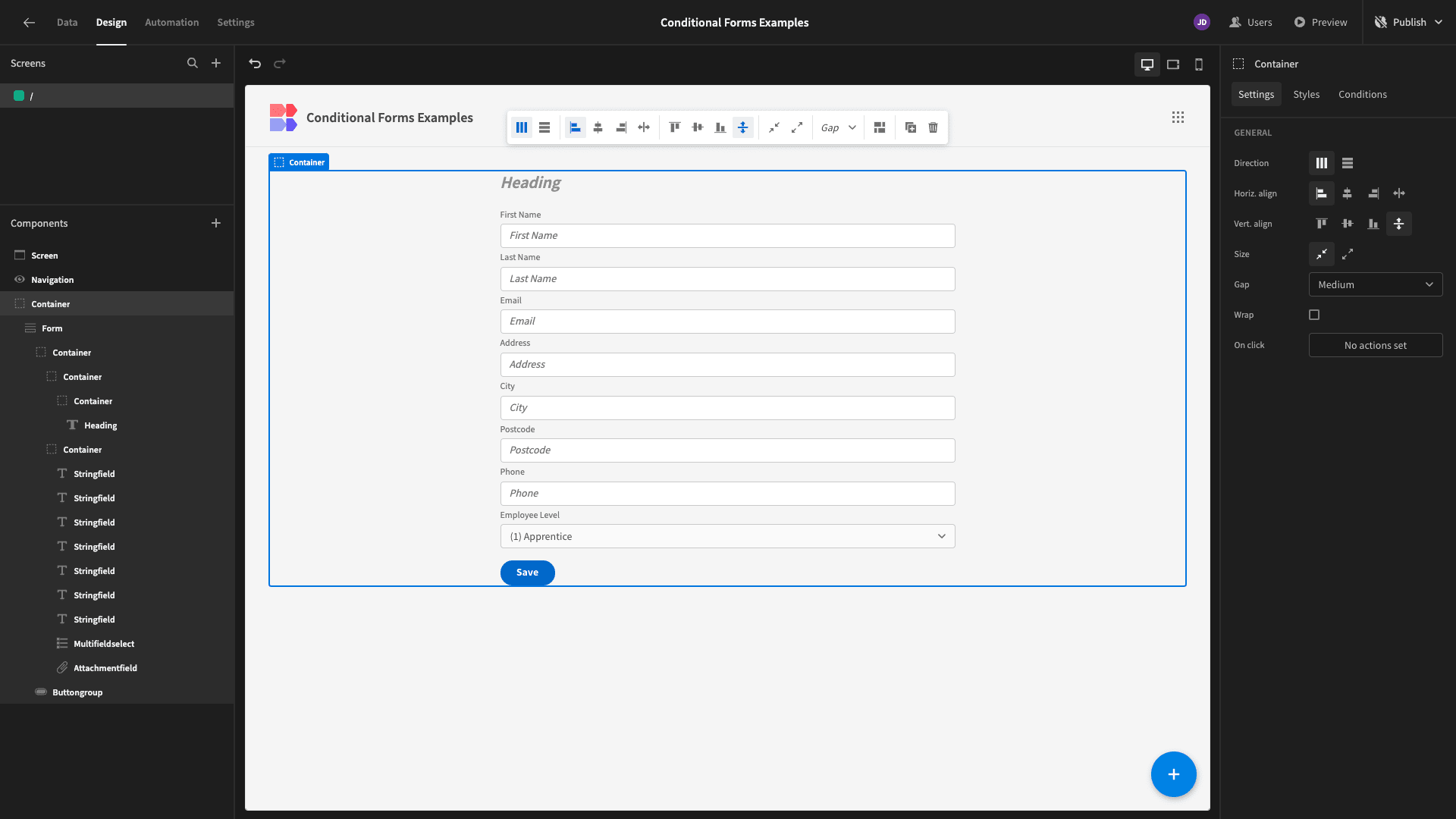
2. User attribute conditions
LetŌĆÖs try something a bit more advanced. Besides branching logic, another key use for conditionality within forms is personalization.
HereŌĆÖs the exact same form, except weŌĆÖve updated the headline text to ŌĆ£Welcome!ŌĆØ. Ultimately, weŌĆÖd like to personalize this message a little bit, but we can obviously only do that if we know the userŌĆÖs name.
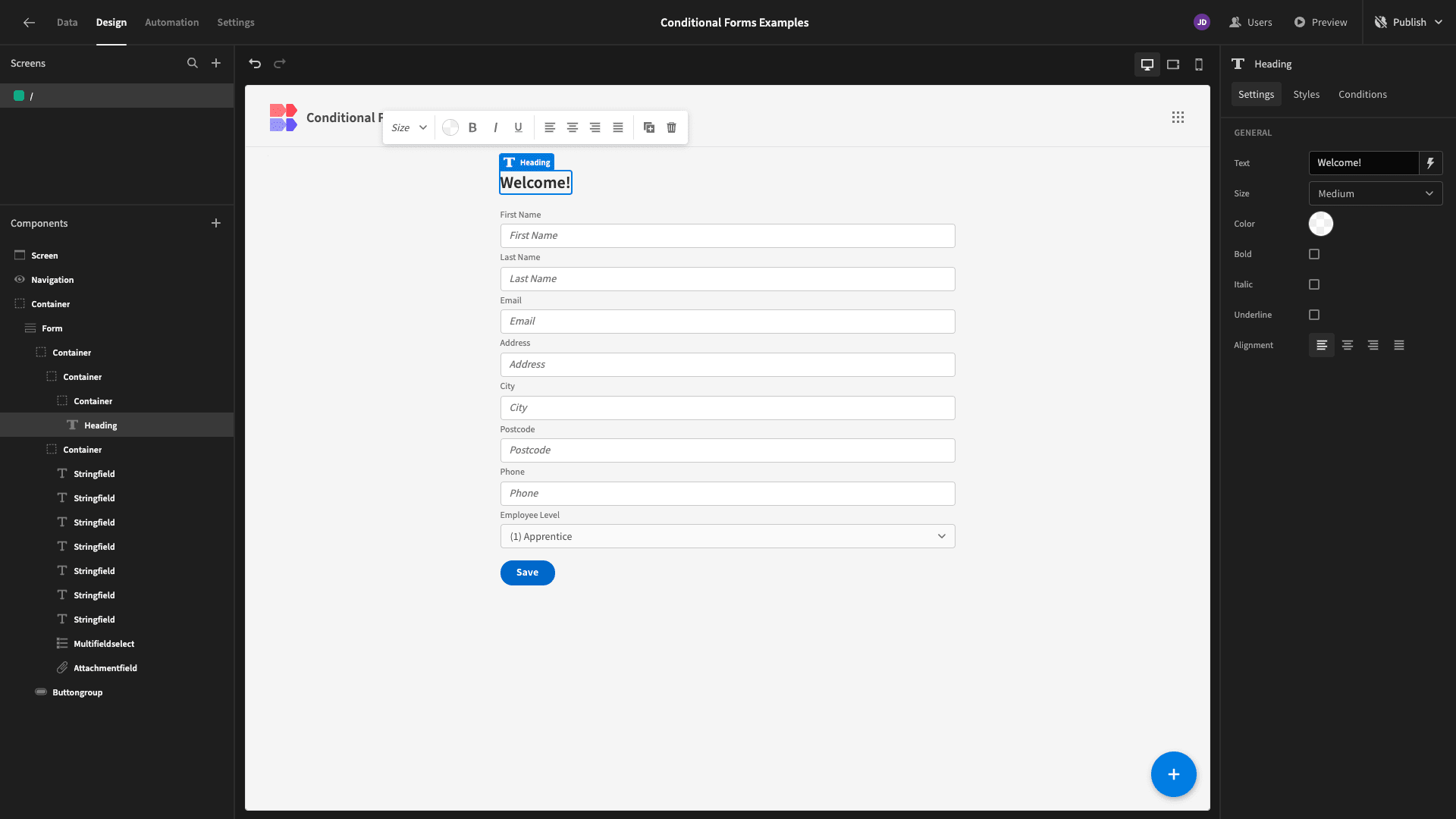
Otherwise, weŌĆÖll want to fall back on this generic default message.
WeŌĆÖve opened the conditionality editor for our Headline component, this time choosing the ŌĆ£Update SettingŌĆØ option:
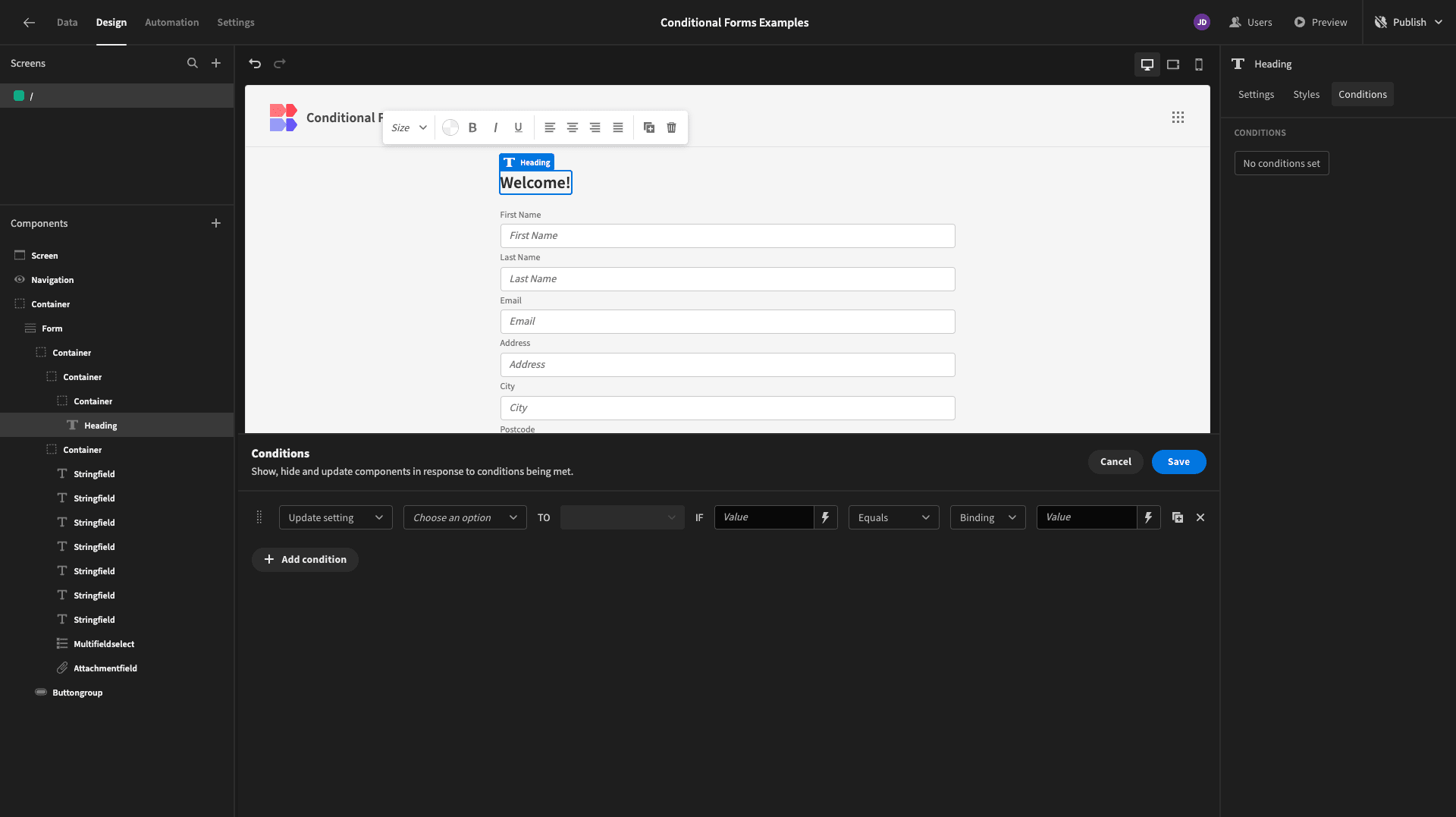
We can then choose which of this componentŌĆÖs settings our rule will alter. WeŌĆÖve selected Text:
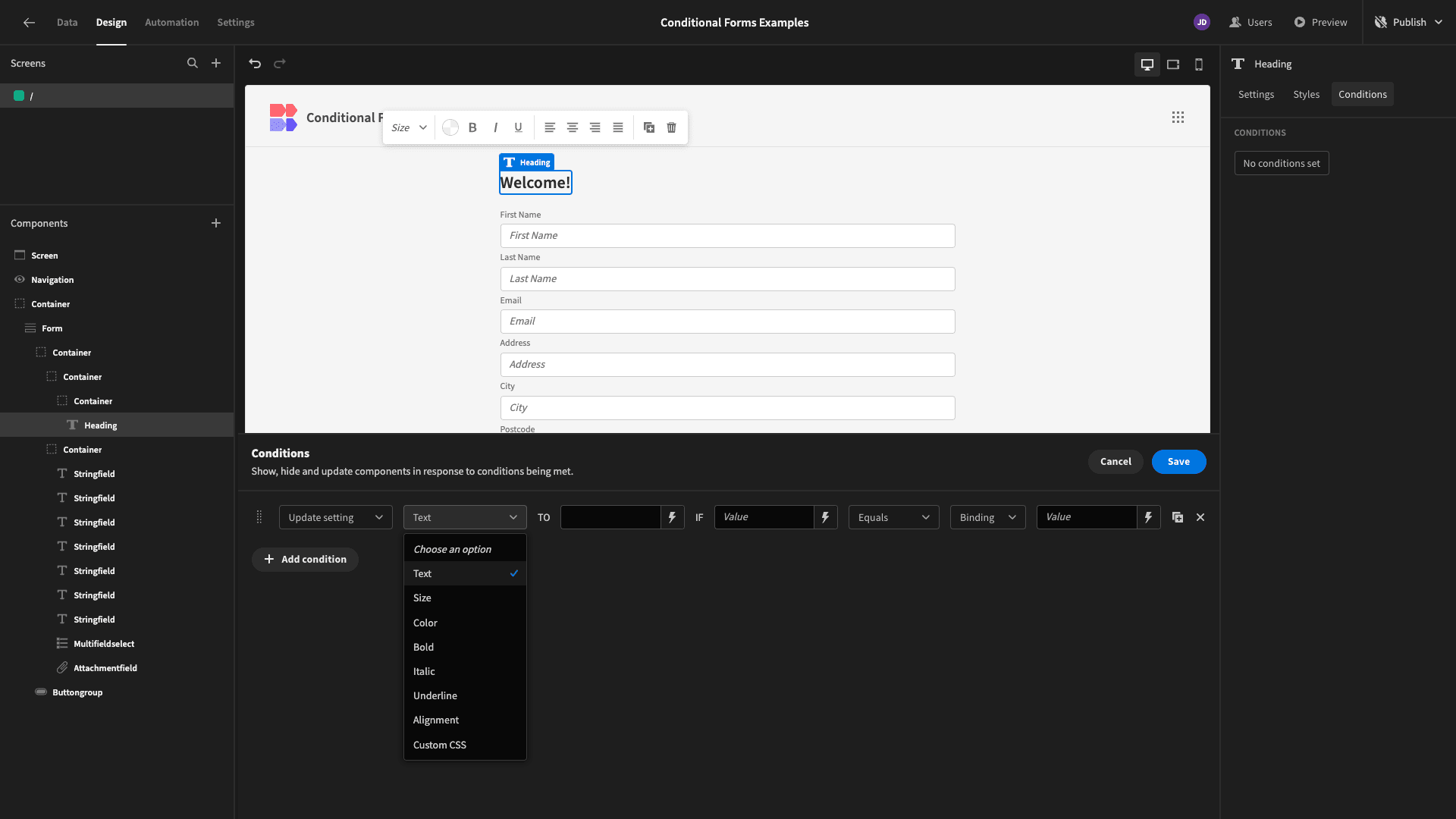
We want our form to say ŌĆ£WelcomeŌĆØ followed by the current userŌĆÖs first name. So, weŌĆÖll open the Current Users options:
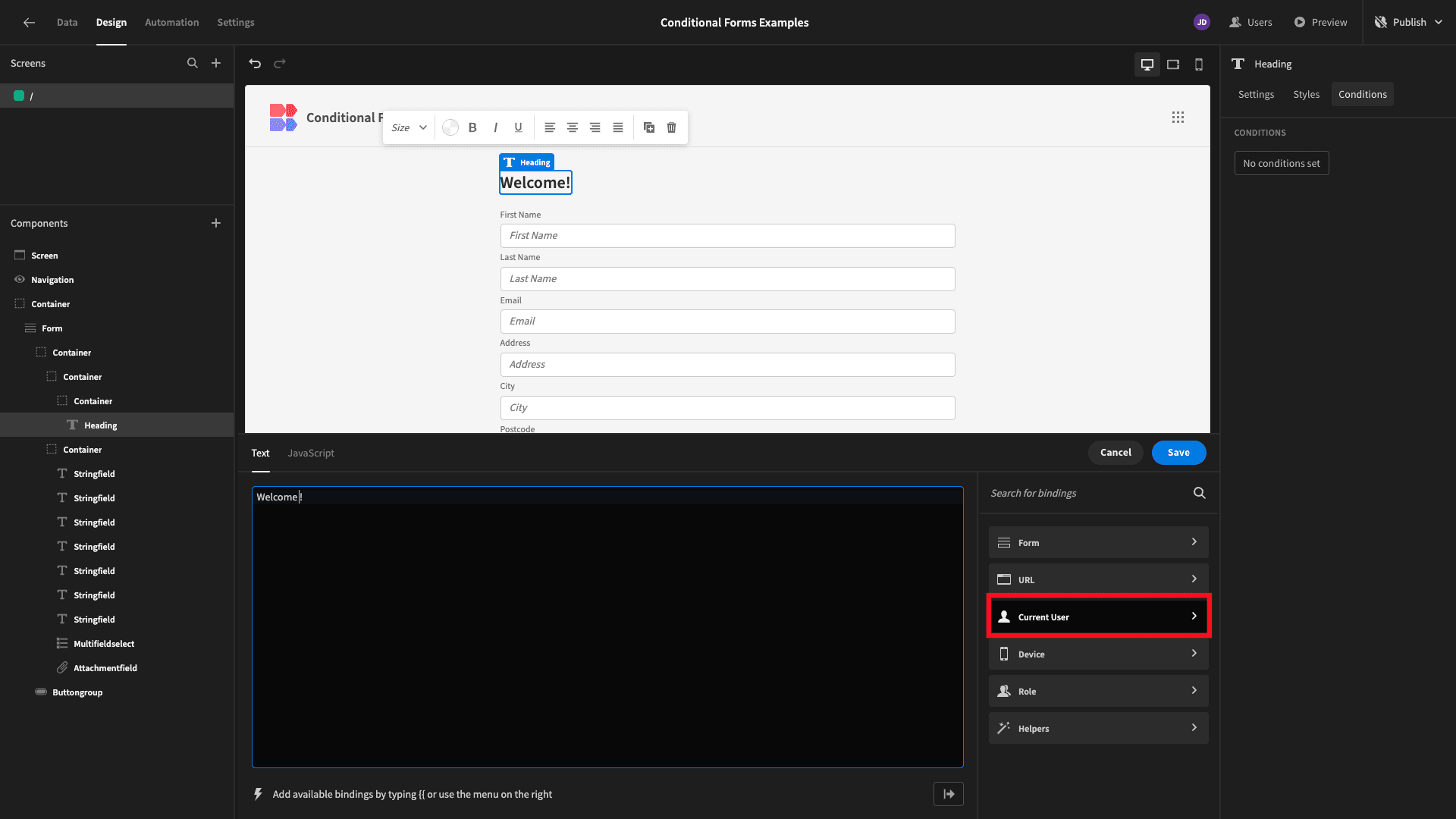
And weŌĆÖre selecting firstName:
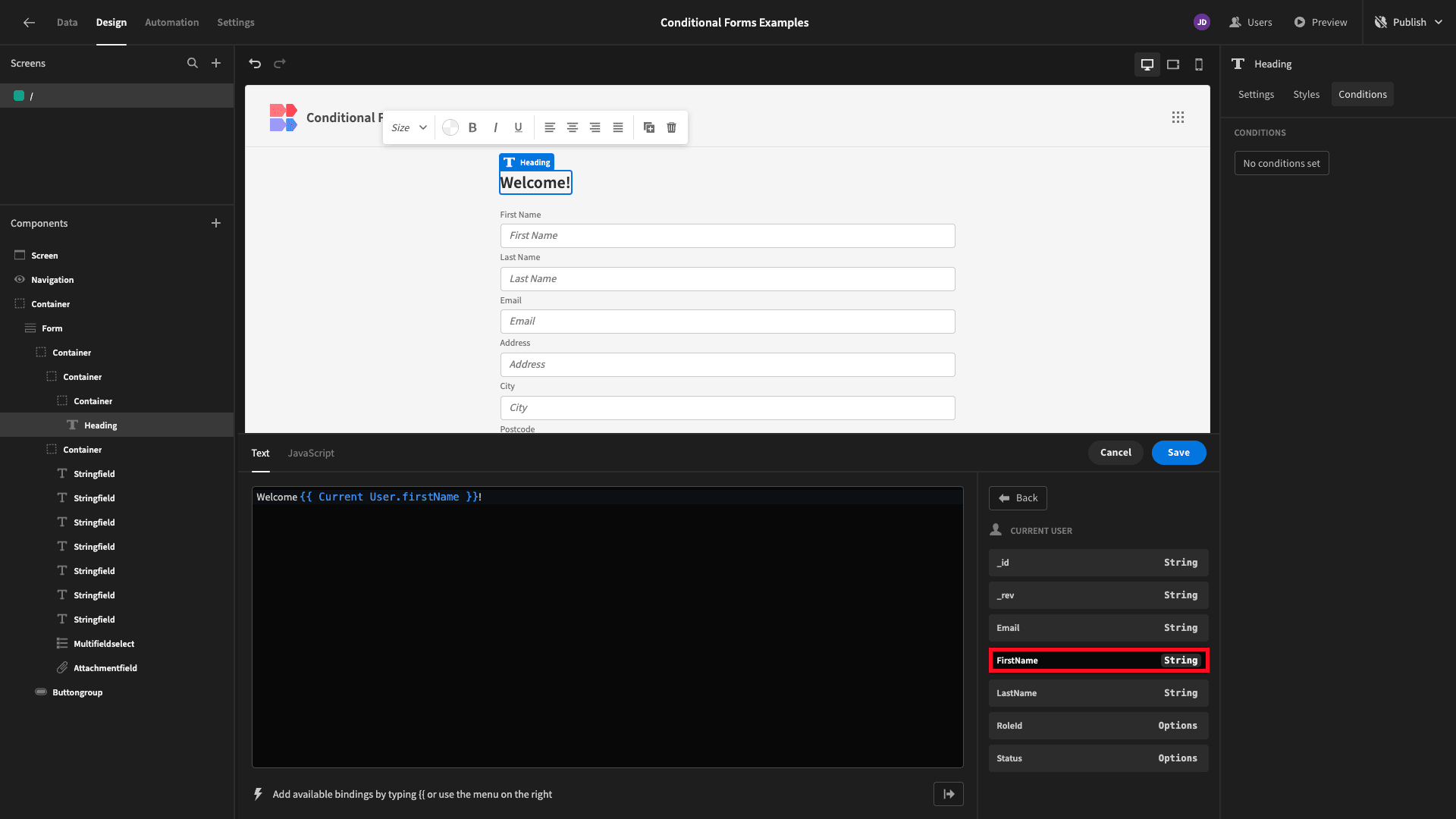
Now, weŌĆÖve set our action and our reference value. We still need to add our operator and our comparison value. We want to display this personalized text if we know the current userŌĆÖs first name.
In other words, if this field is not null.
So weŌĆÖll select {{ Current User.firstName }} as our comparison value, and weŌĆÖll use Is Not Empty as our operator:
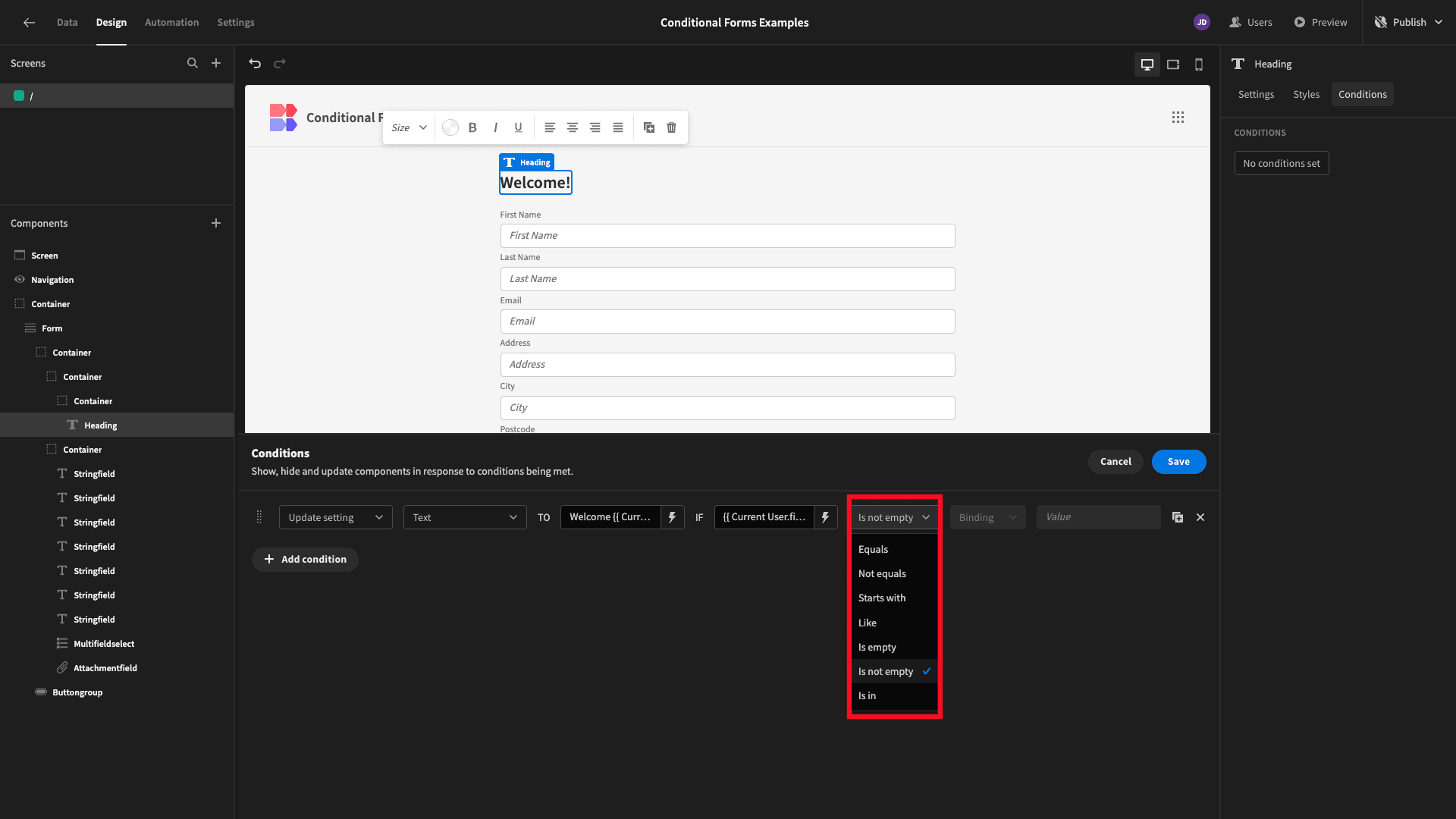
And hereŌĆÖs the result:
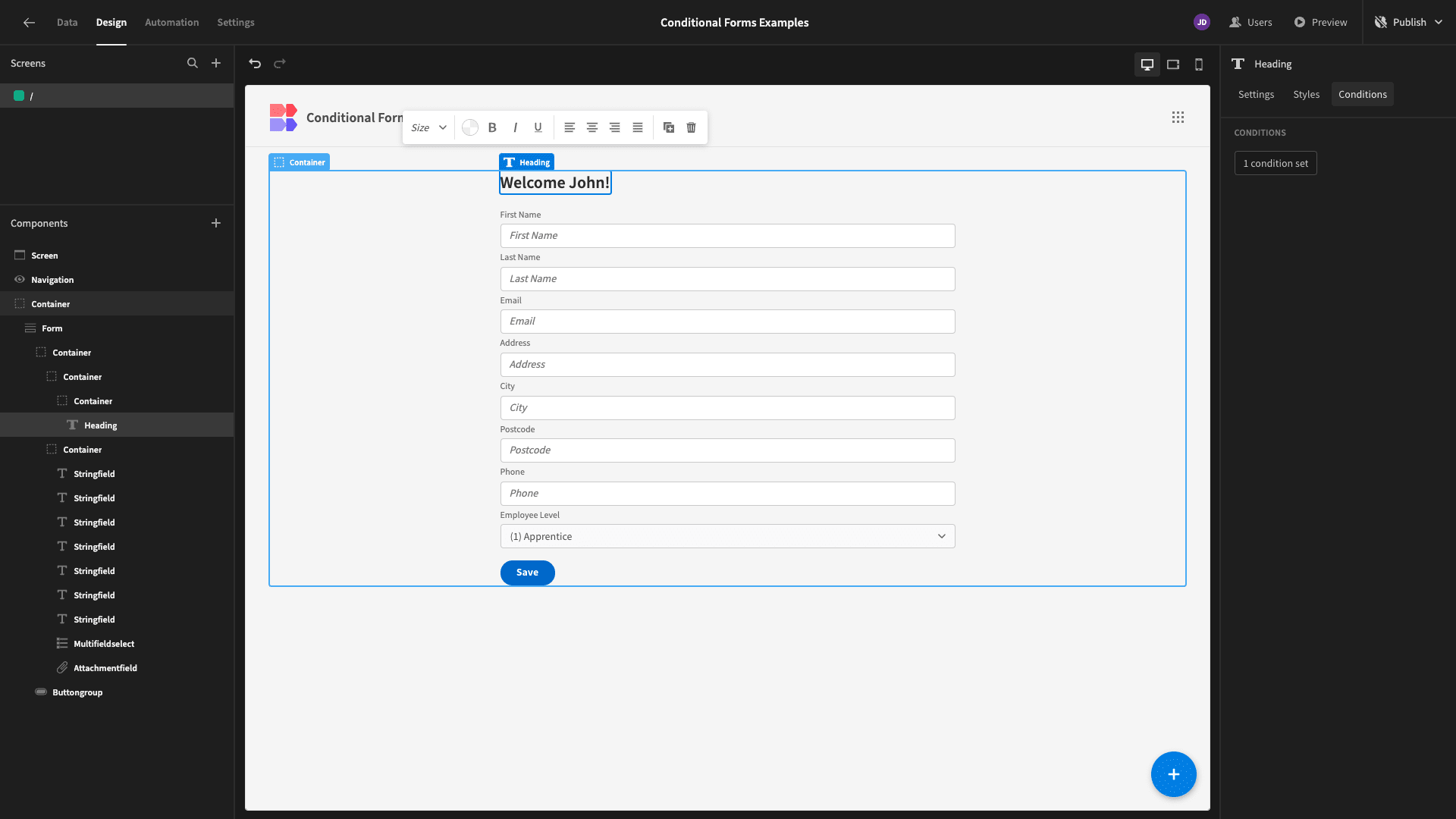
3. User role conditions
Another use case for conditional logic forms is governing which specific data attributes certain users are allowed to update. In other words, we might have some form fields that we want to reserve for higher access roles.
WeŌĆÖve added two additional form fields called Start Date and End Date.
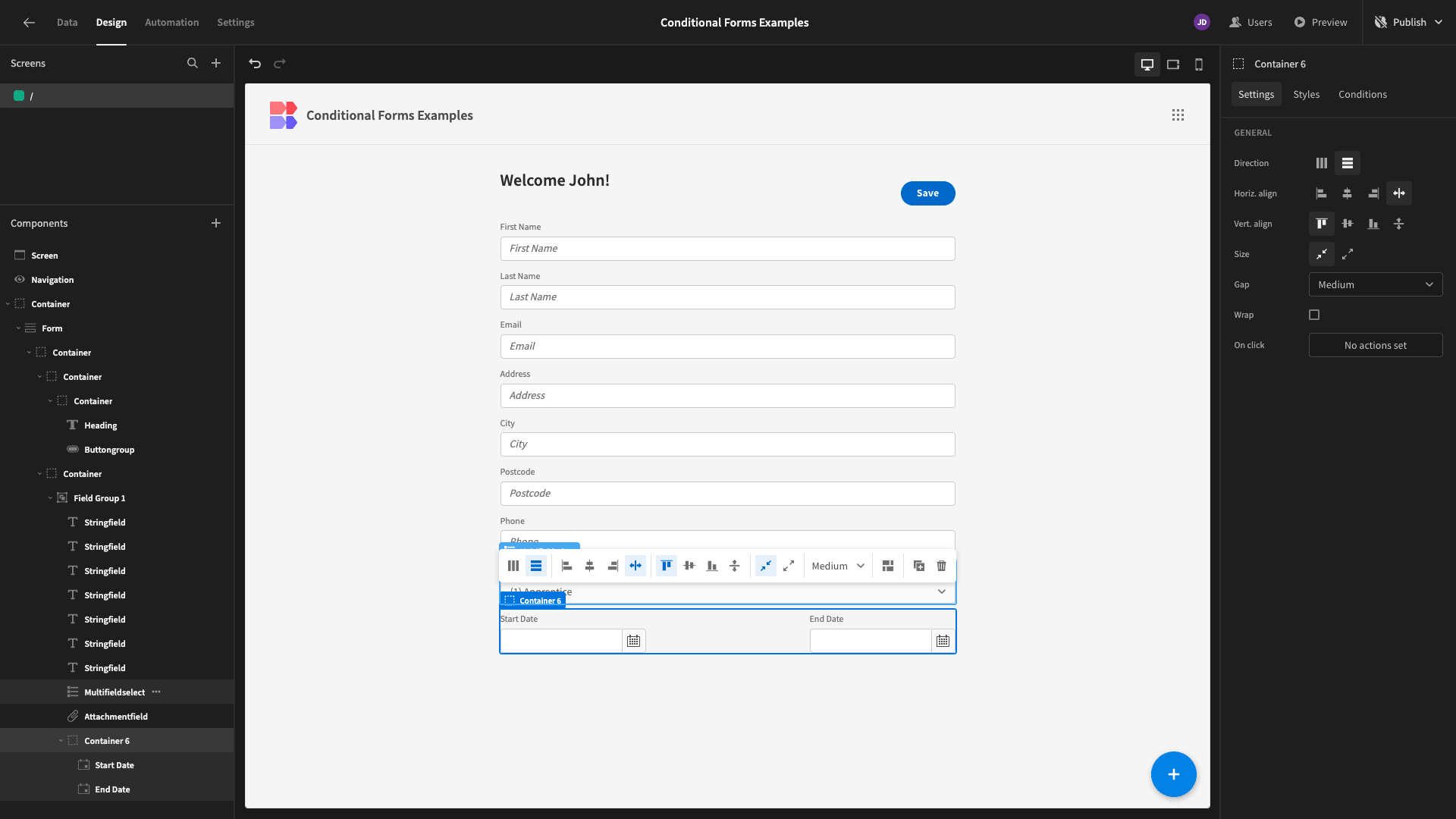
We always want to display these, but we only want them to be editable by users with an Admin role.
For each of our new fields, weŌĆÖll need to start by creating an Update Setting rule again. This time, the setting weŌĆÖre choosing is called Disabled, and weŌĆÖre updating it to be selected:
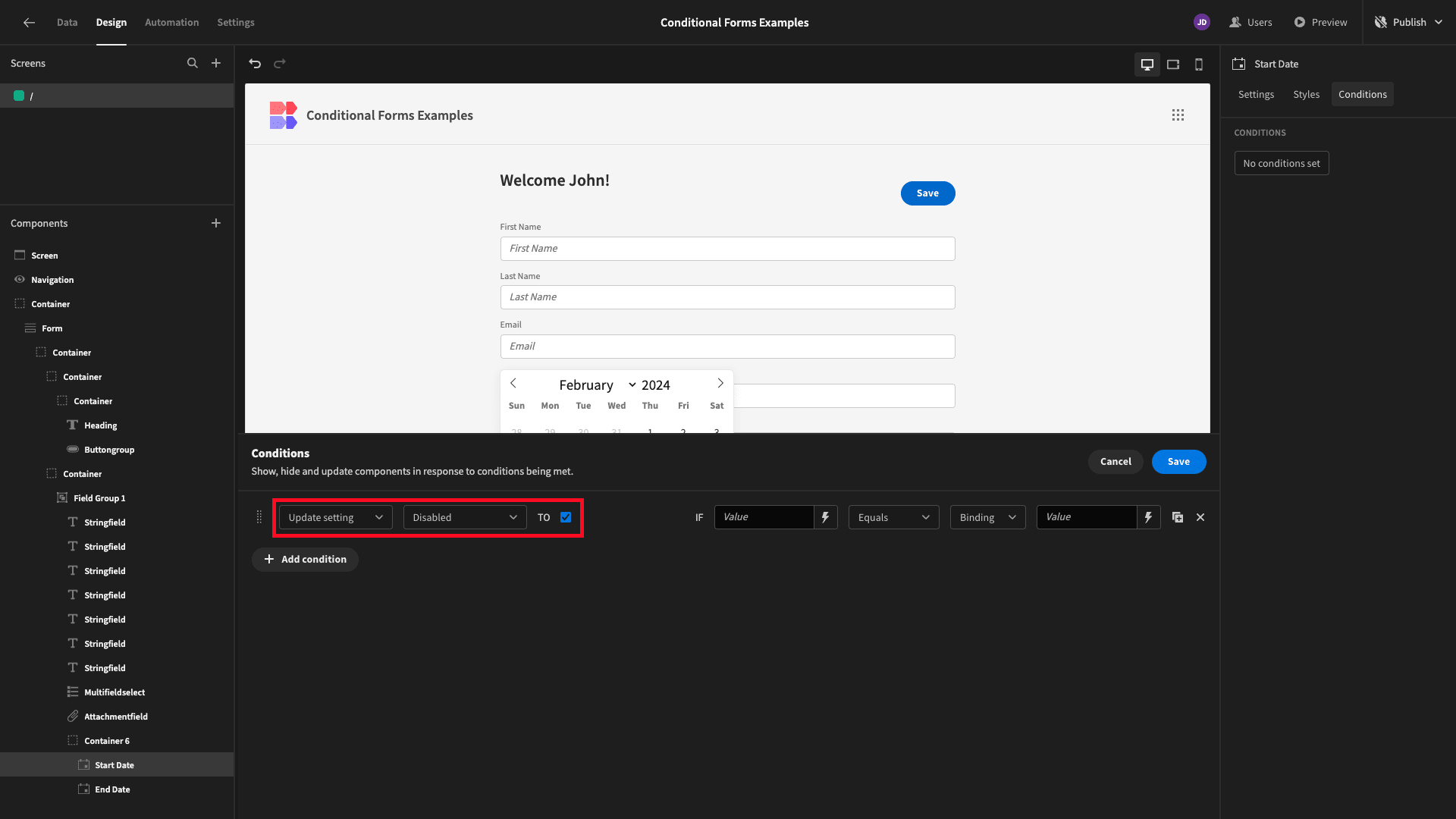
The reference value is another Current User field called roleId:
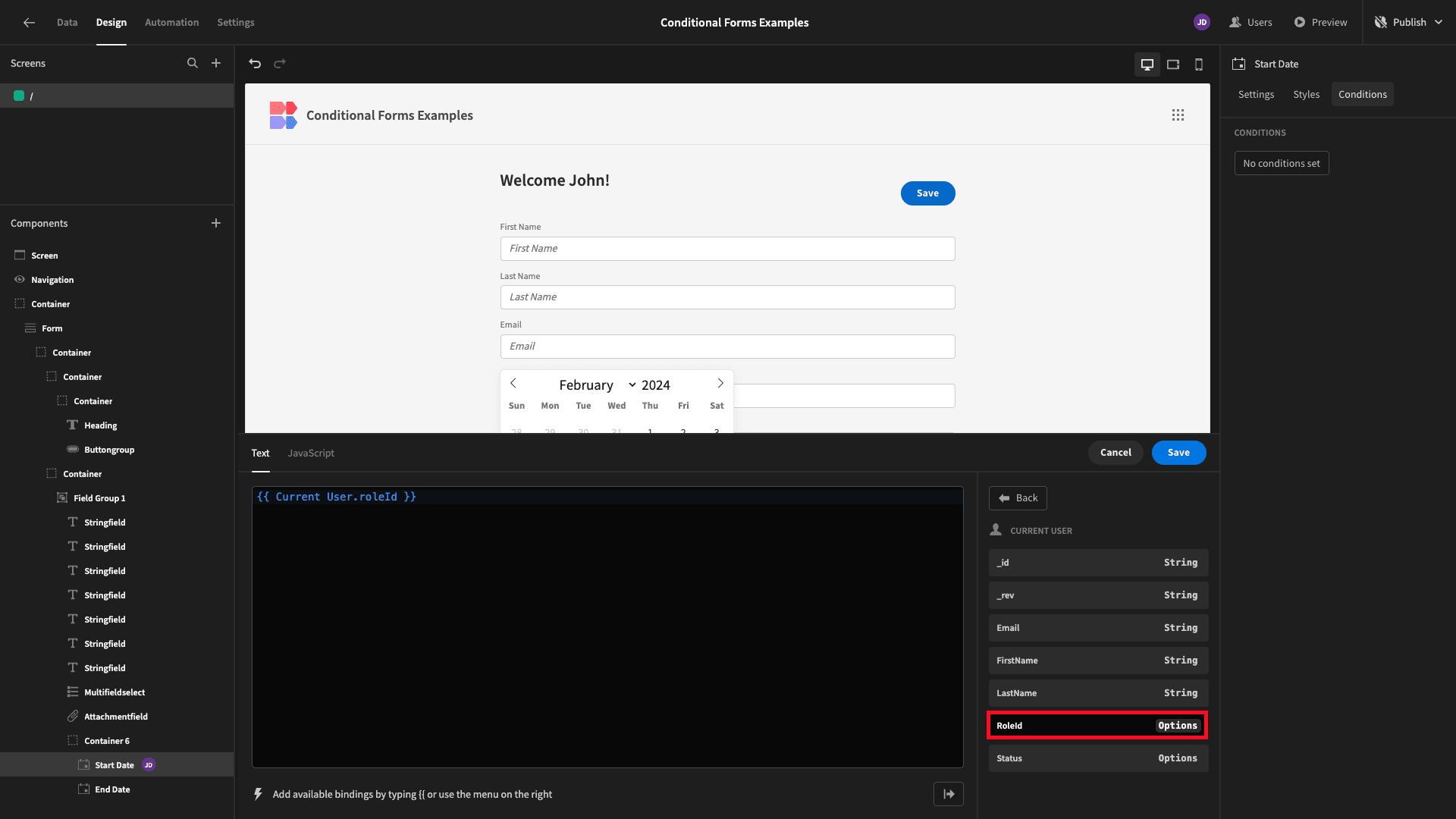
║┌┴Žš²─▄┴┐ has four built-in access roles, each with a name and a corresponding ID. We can access the ID attribute for these under the Role heading in the bindings drawer for our comparison value:

These fields should only be editable for users with an Admin role, so thatŌĆÖs what weŌĆÖre choosing:

WeŌĆÖre also choosing Not Equals for our operator:
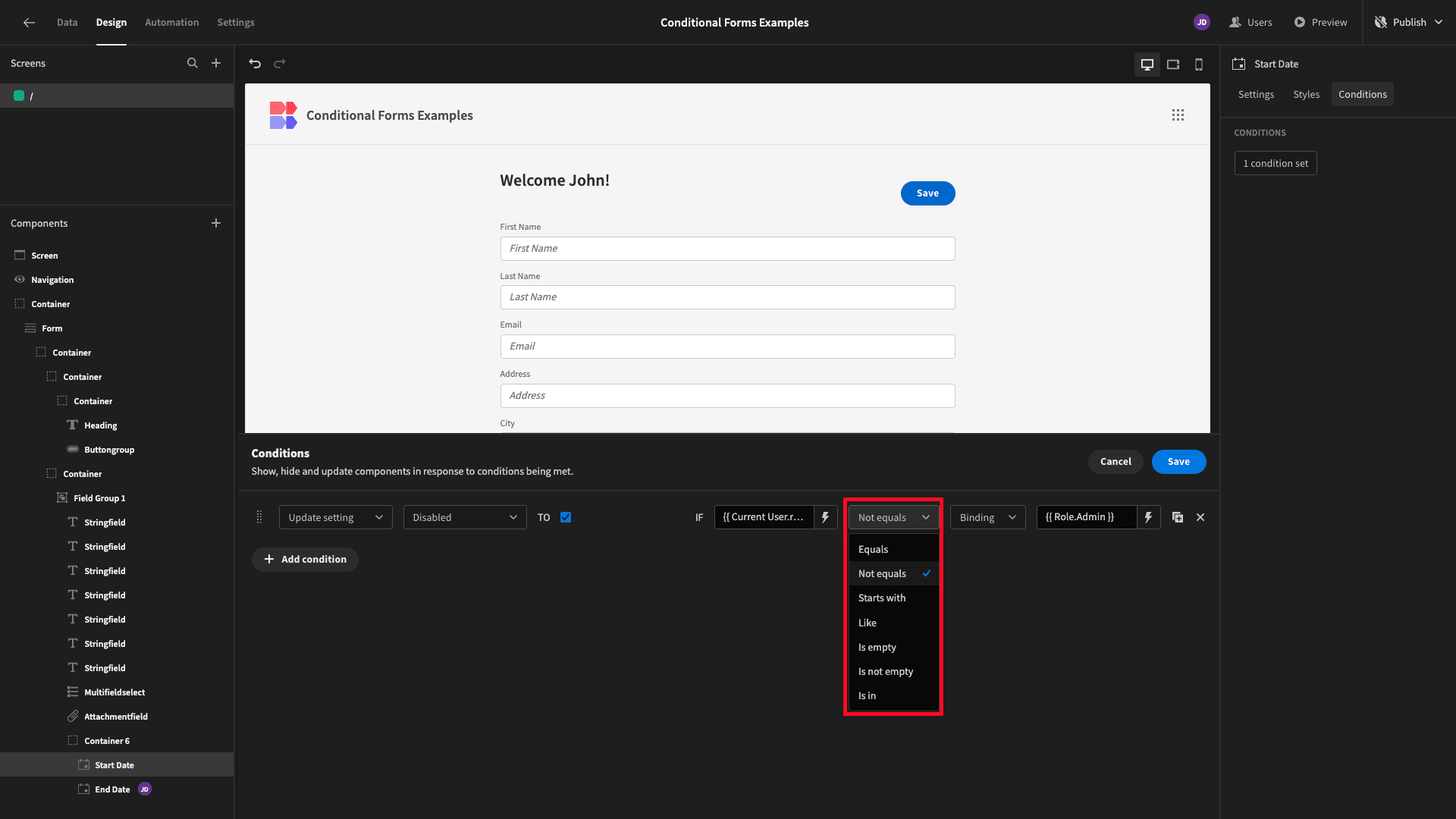
We have an Admin account on our ║┌┴Žš²─▄┴┐ tenant, so these fields still appear as editable for us in the builder:
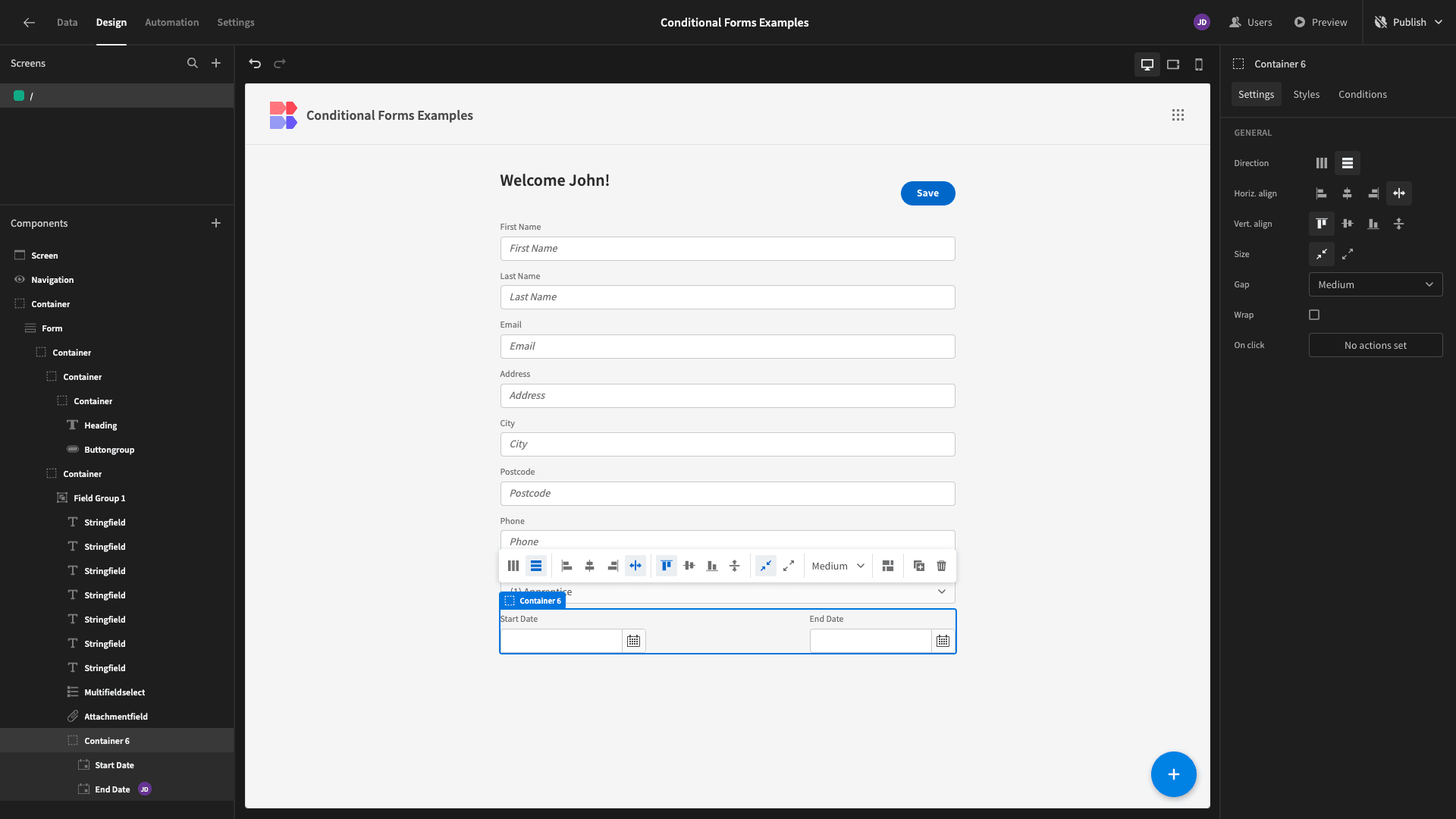
However, when we preview our app as a Basic user, theyŌĆÖll be disabled:
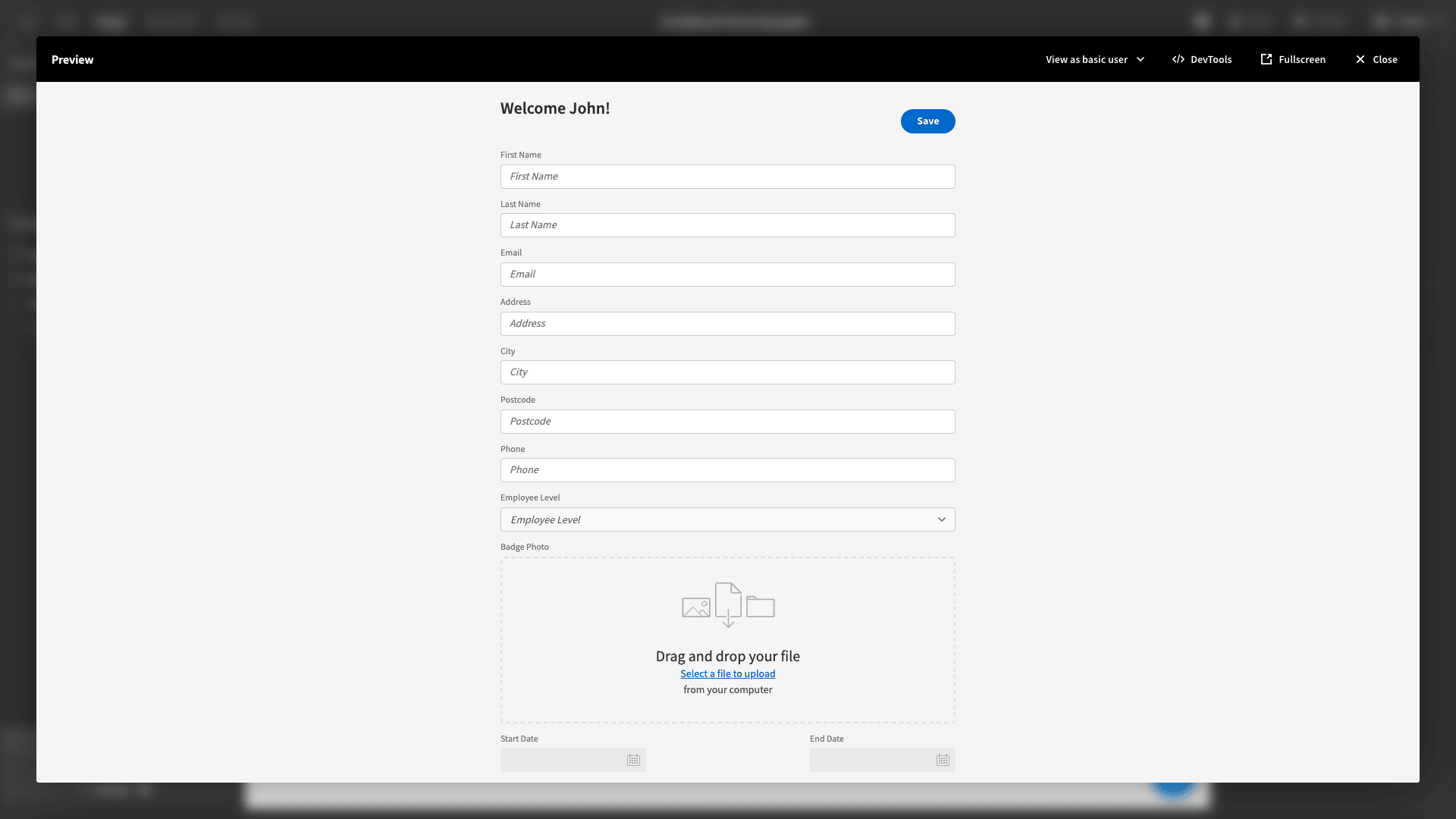
4. Contextual conditions
We can also use contextual information to apply conditions to our form UI. WeŌĆÖve made another modification to our form, this time wrapping the First Name and Last Name fields in a horizontal container so they appear on a single line:
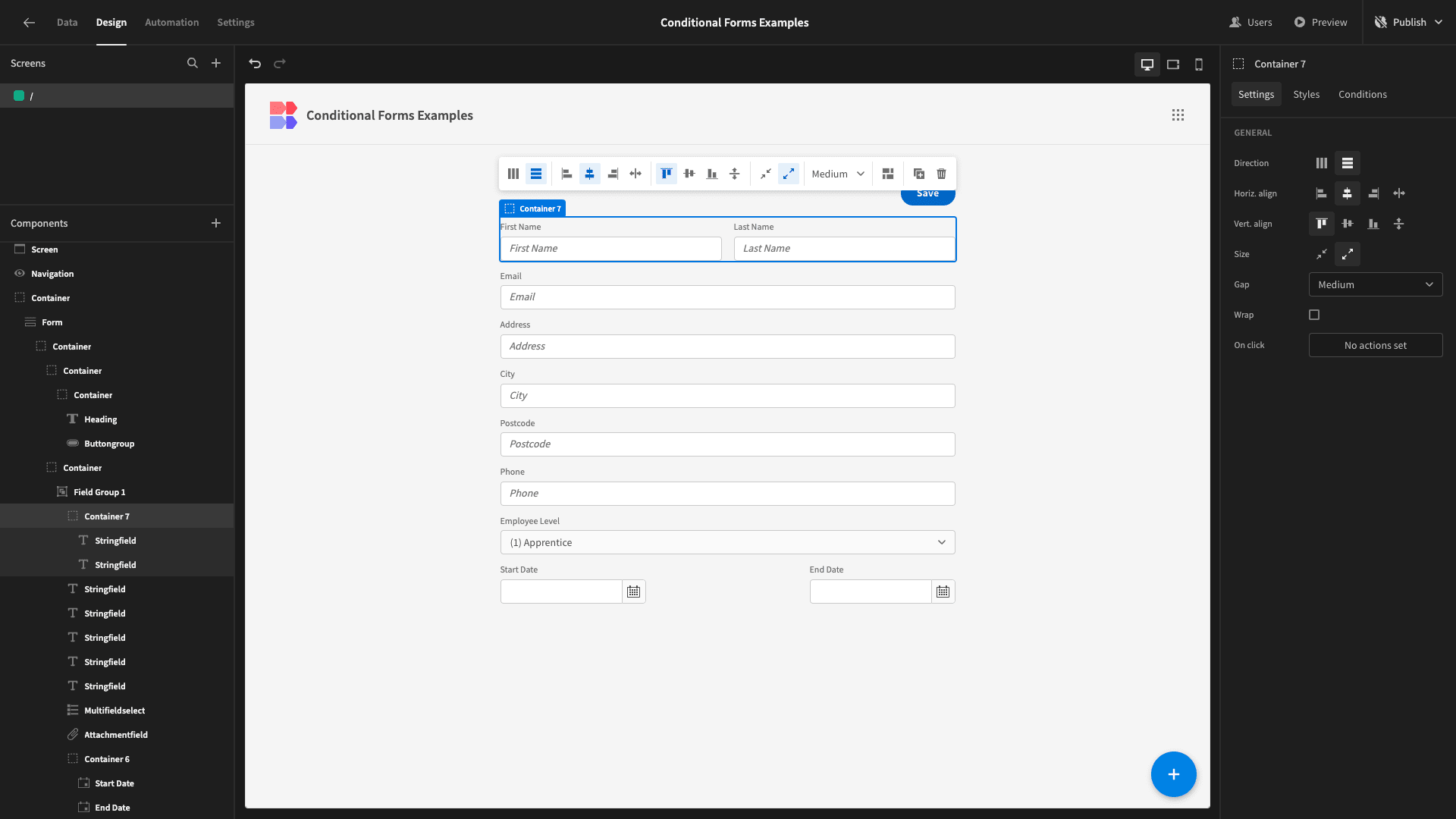
This is a better UX if we access our form on a desktop, but it doesnŌĆÖt work as nicely on mobile:
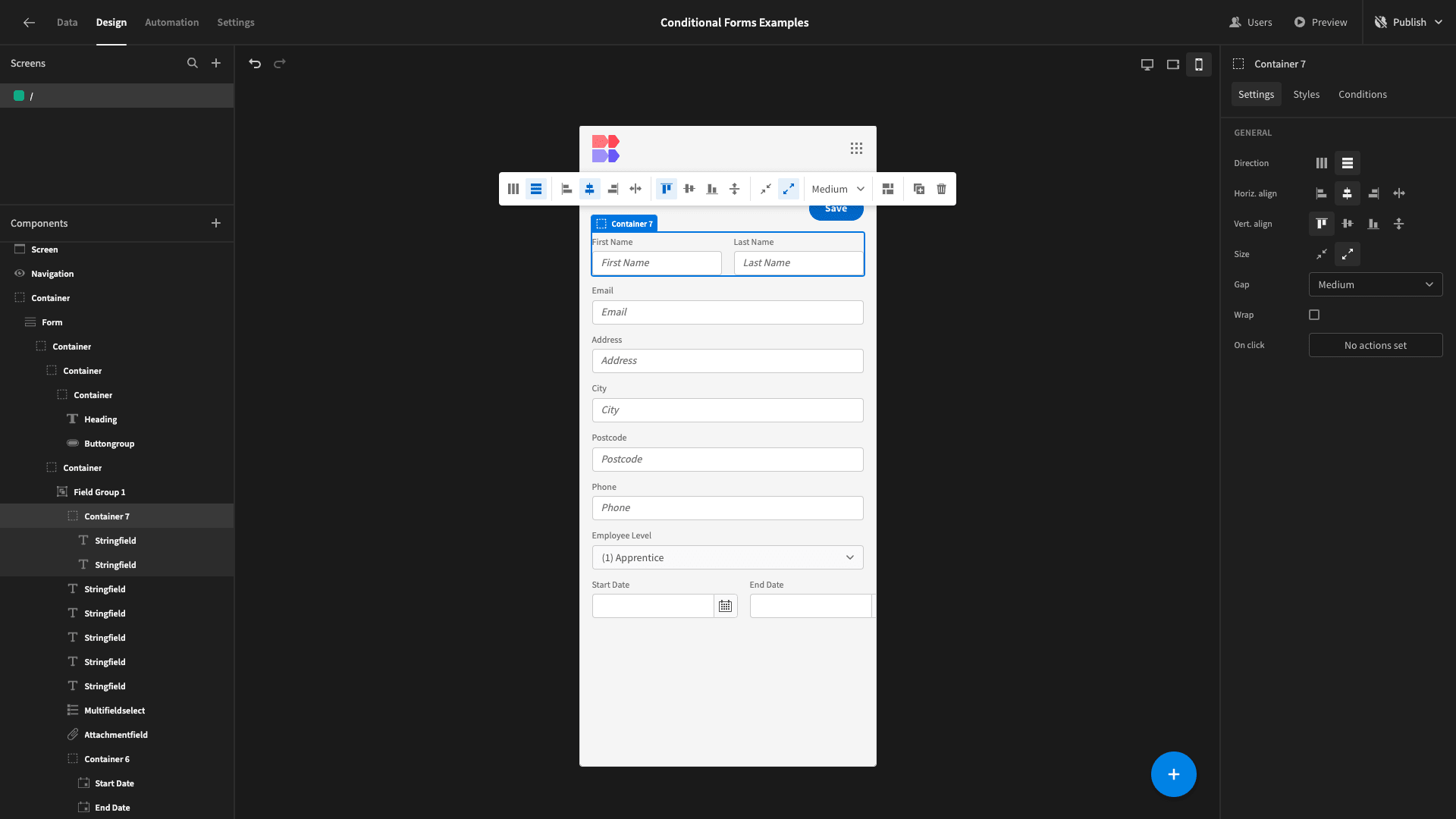
WeŌĆÖre going to create a condition for our new container that updates its Direction setting to Vertical:
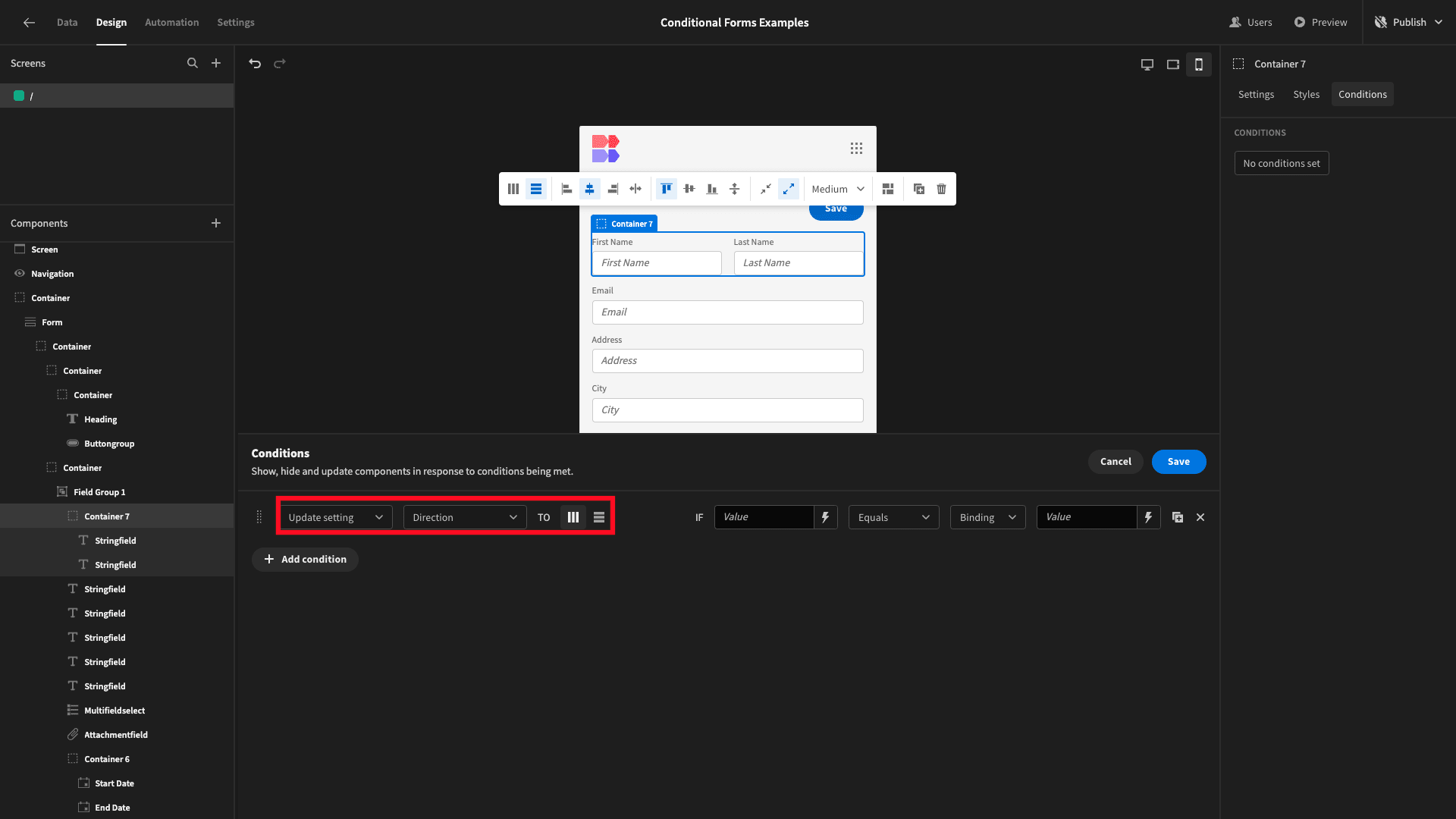
We want to apply this setting when the current userŌĆÖs device is a mobile phone. WeŌĆÖve got a category of helpers called Device:

Inside this, we can choose Mobile:
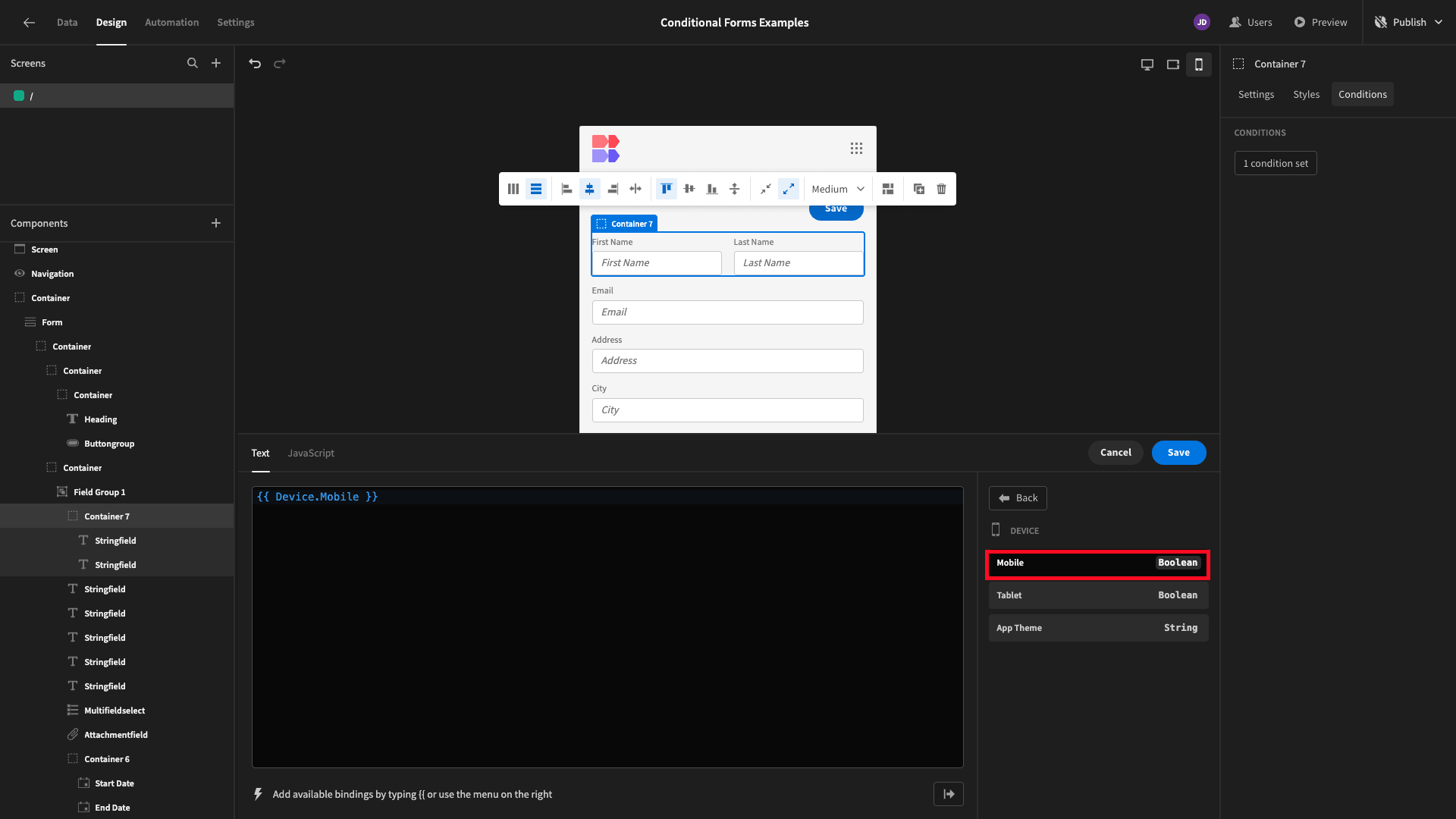
This is a contextual boolean variable that evaluates to true when a user accesses our form from a mobile device. So, instead of binding a comparison value, weŌĆÖll select Boolean:
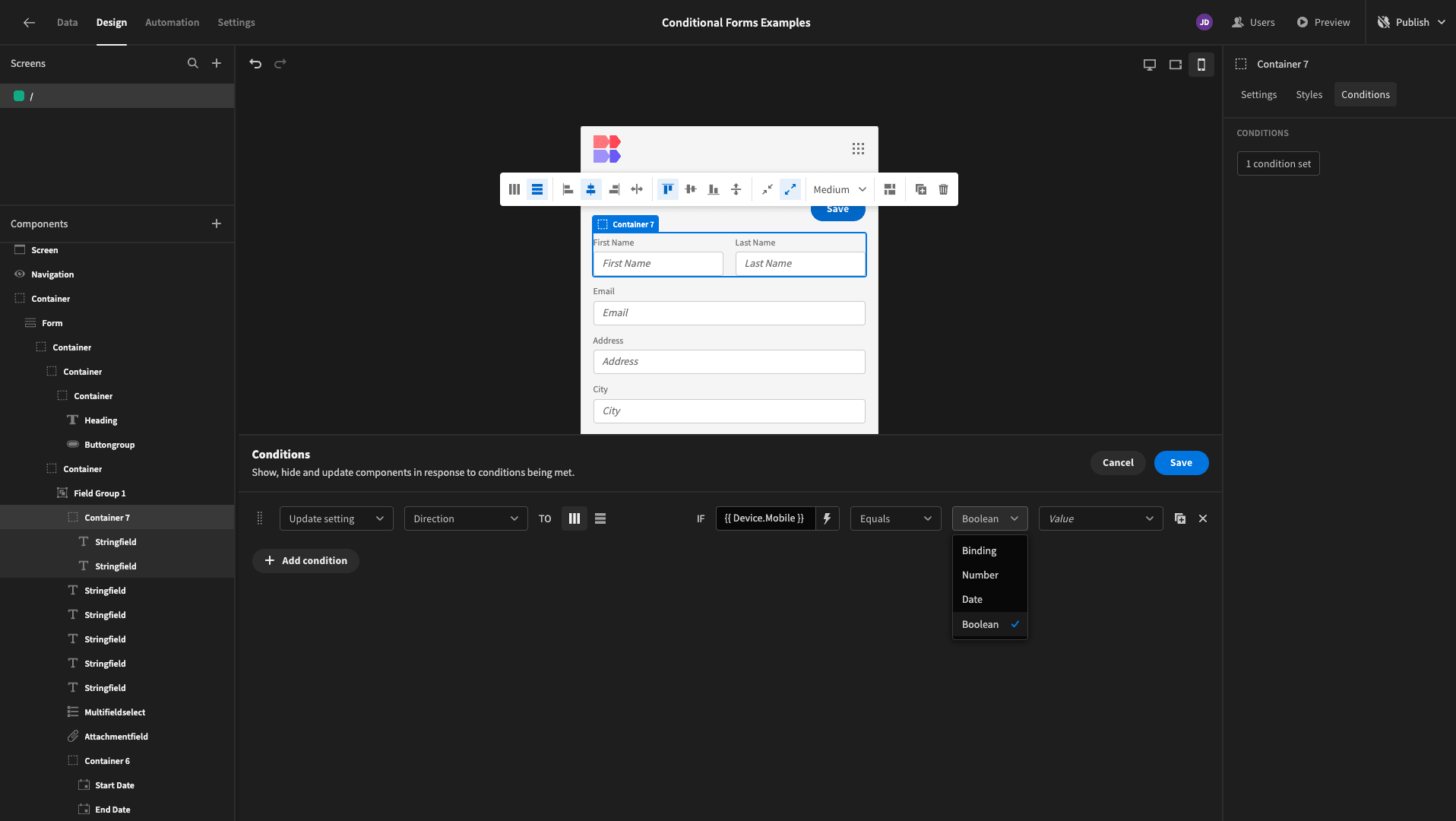
And lastly, weŌĆÖll set our comparison value to True:
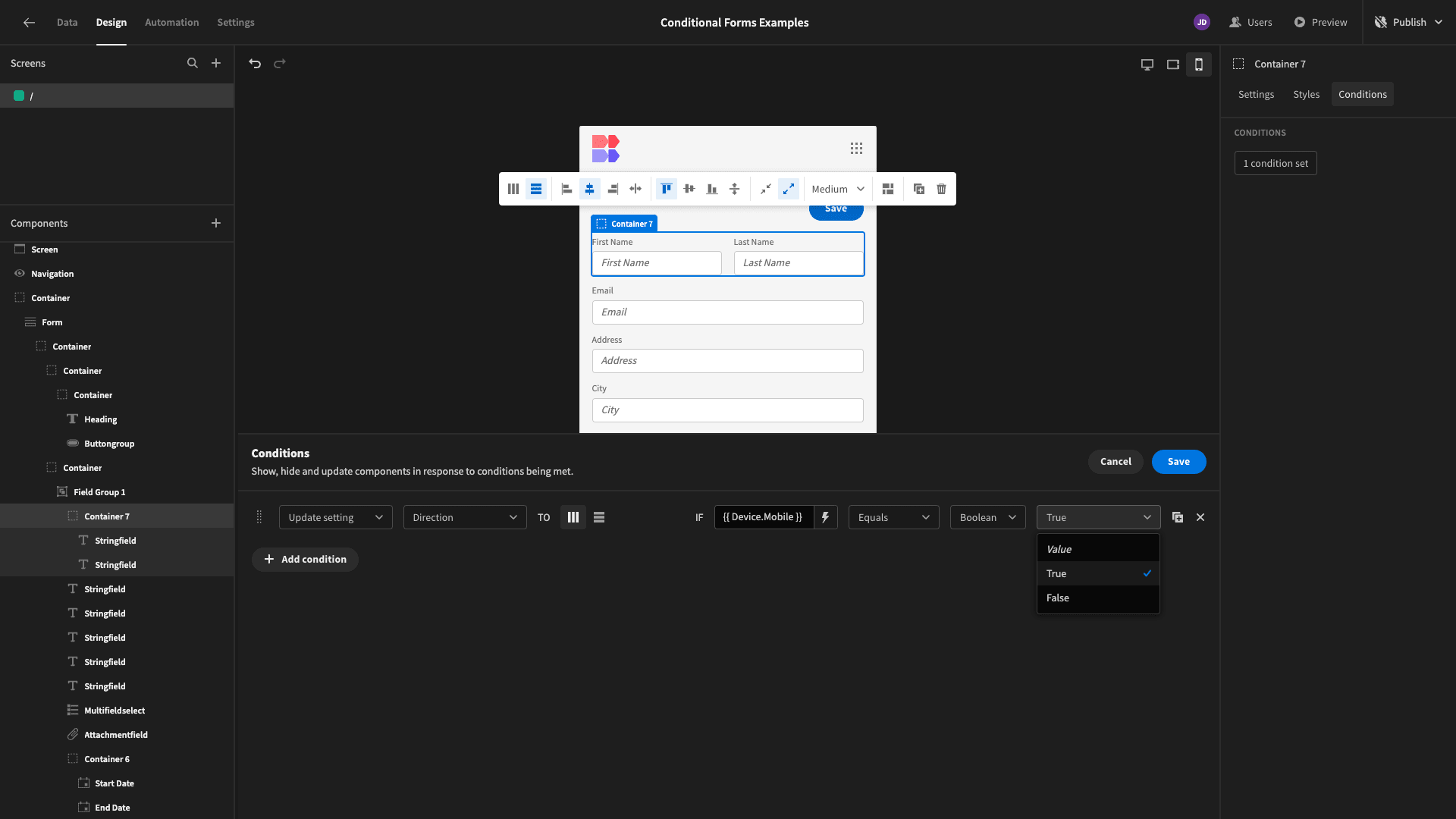
When we apply this rule, our name fields will be arranged vertically for mobile users:
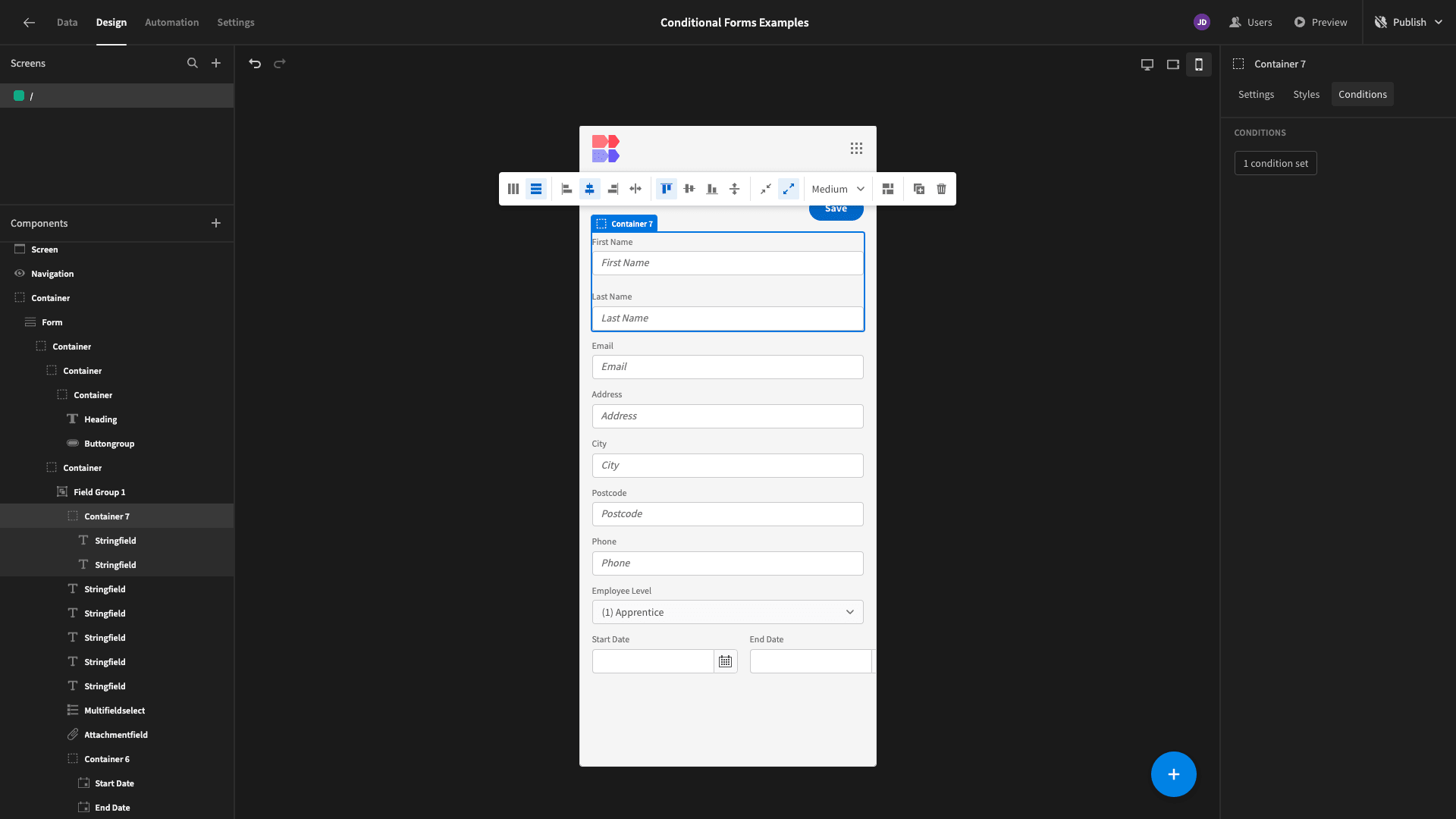
5. Advanced conditionality rules
║┌┴Žš²─▄┴┐ stands head and shoulders above traditional form builders for creating advanced, custom solutions. With a built-in automation builder, extensive external data support, custom front-end scripting, and more, thereŌĆÖs huge scope for building complex conditionality rules.
We can connect to just about any API or data source - and use query responses however we want.
This means that we can create conditional logic within our forms that would never be possible in traditional form builders that lack this level of connectivity and data support.
To demonstrate this, weŌĆÖve added an API request to our example app.
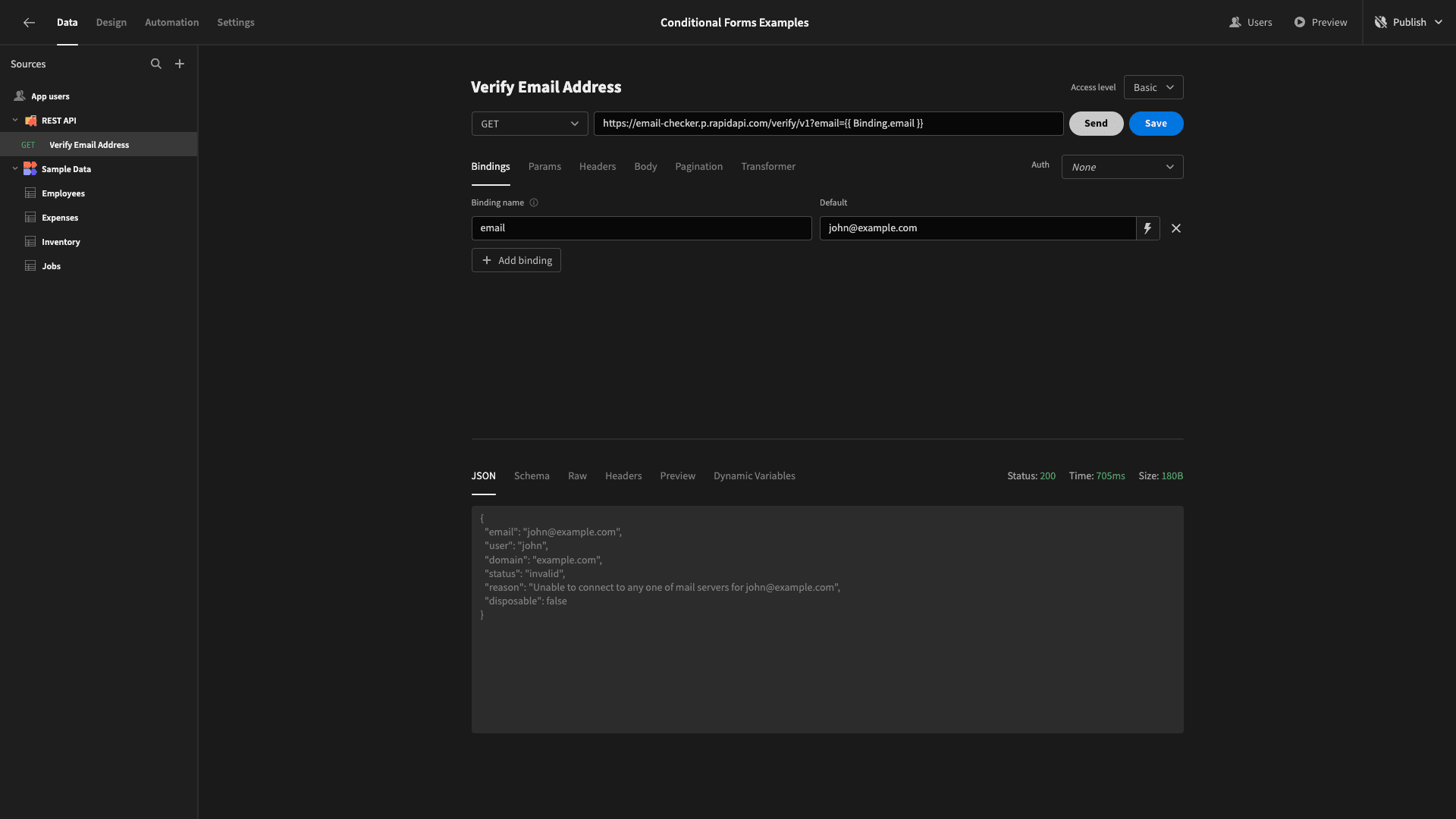
You can check out our to learn more about how this works.
Our API request accepts a bindable value to represent an email address and returns a JSON object with a series of key/value pairs relating to the validity of this. We only care about one of these, which is called status.
This can either return ŌĆśvalidŌĆÖ or ŌĆśinvalidŌĆÖ.
We want to use this information to verify the email address that users submit to our form. WeŌĆÖll then update its design to reflect this.
Back on the design tab, we can open the On-Change actions drawer for our email field:
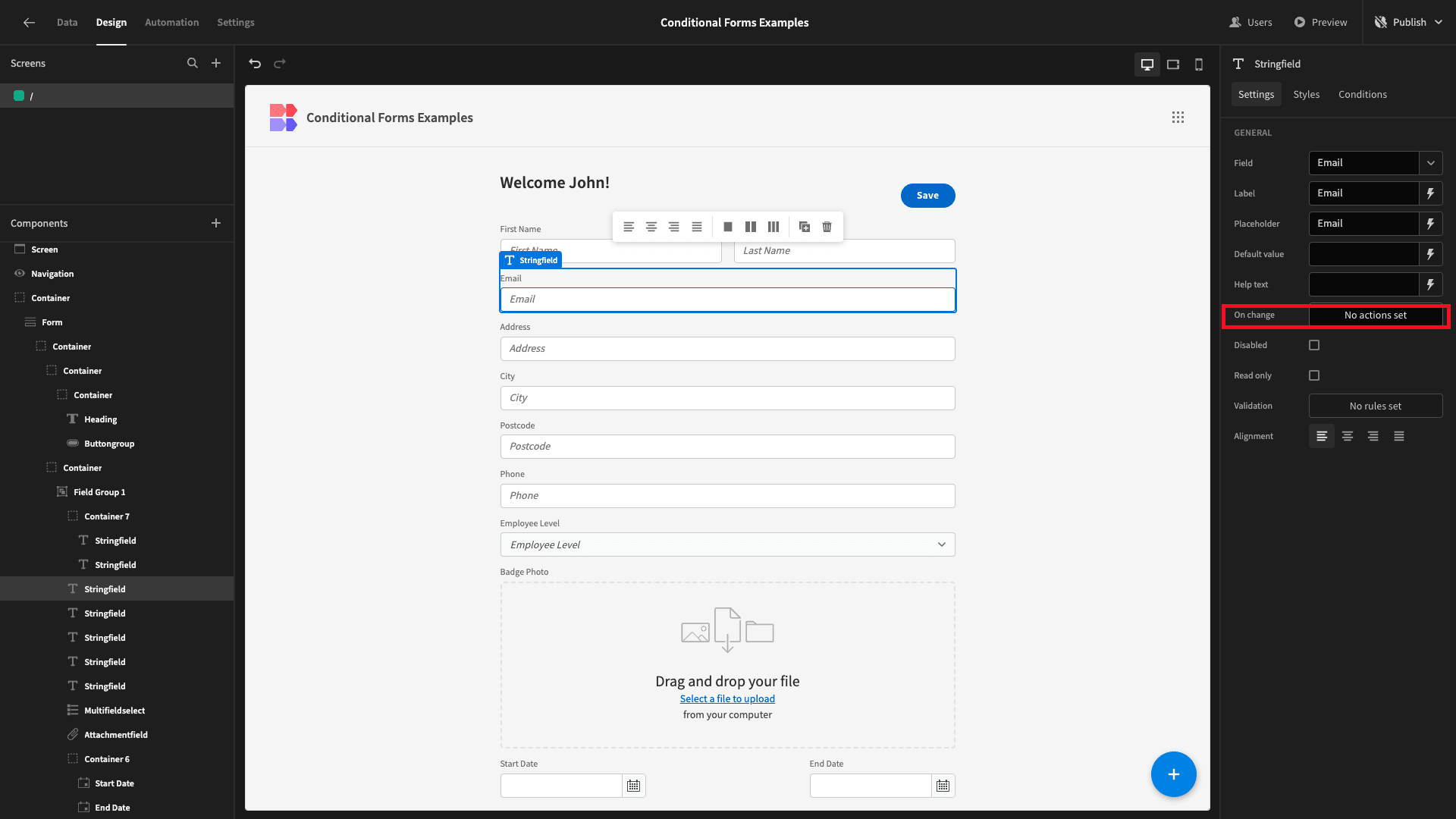
As the name suggests, this allows us to define actions that will be carried out each time the field is updated.
WeŌĆÖre adding an action called Execute Query and setting it to our REST request.
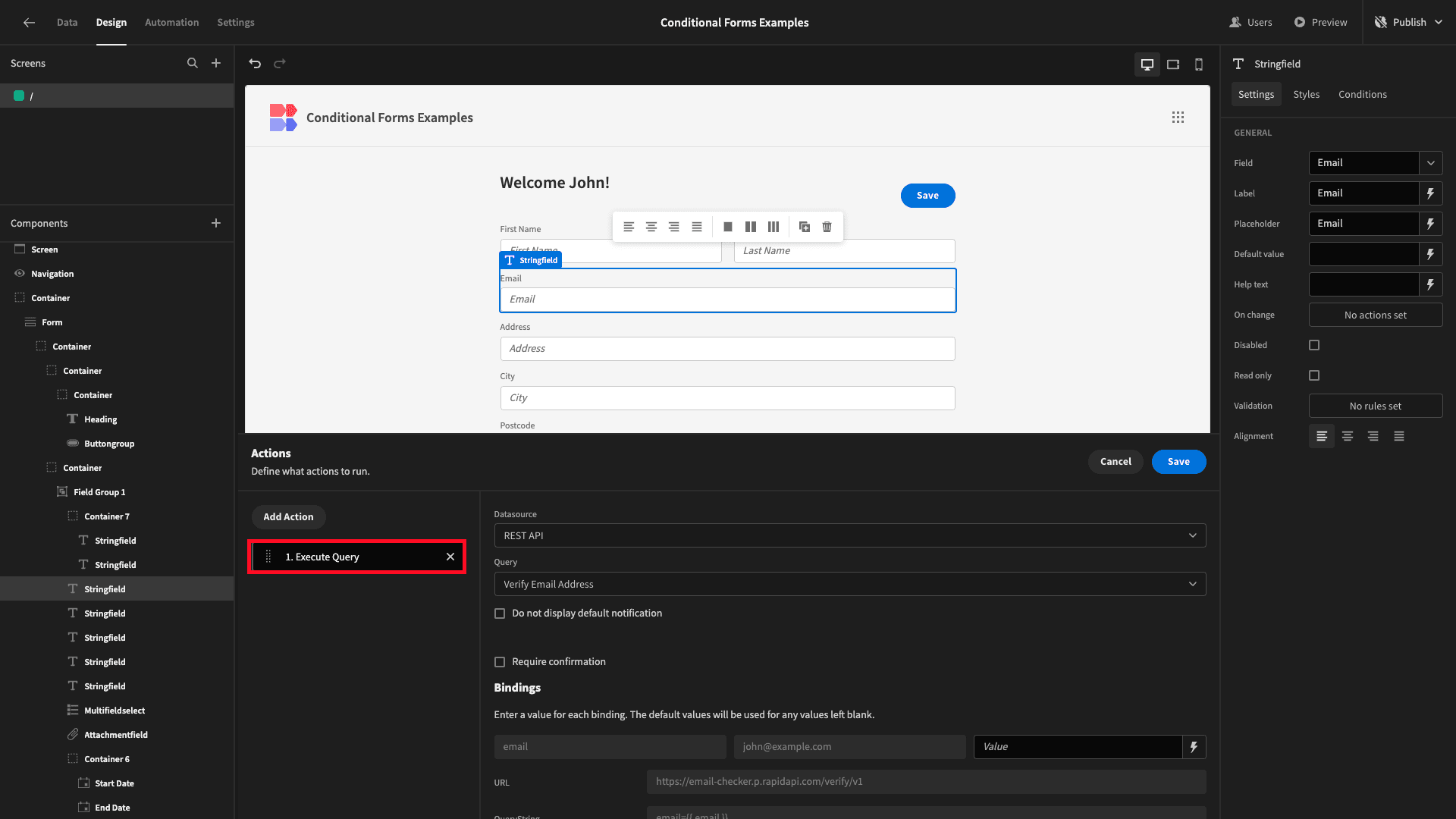
WeŌĆÖll bind the email parameter for this request to the value thatŌĆÖs been submitted in the email field of our form:
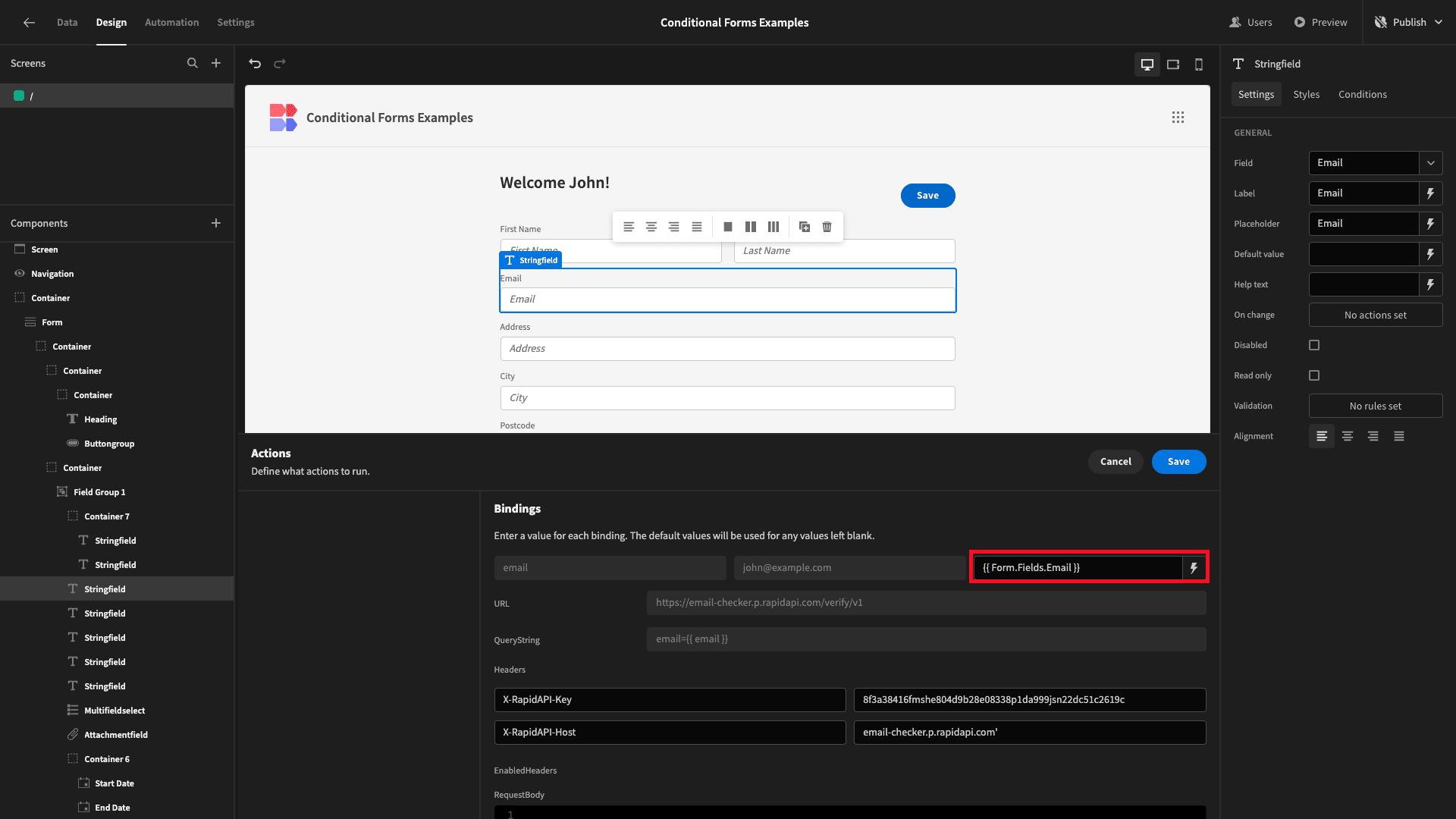
Then, weŌĆÖll add an Update State action to save the status attribute from our query result.
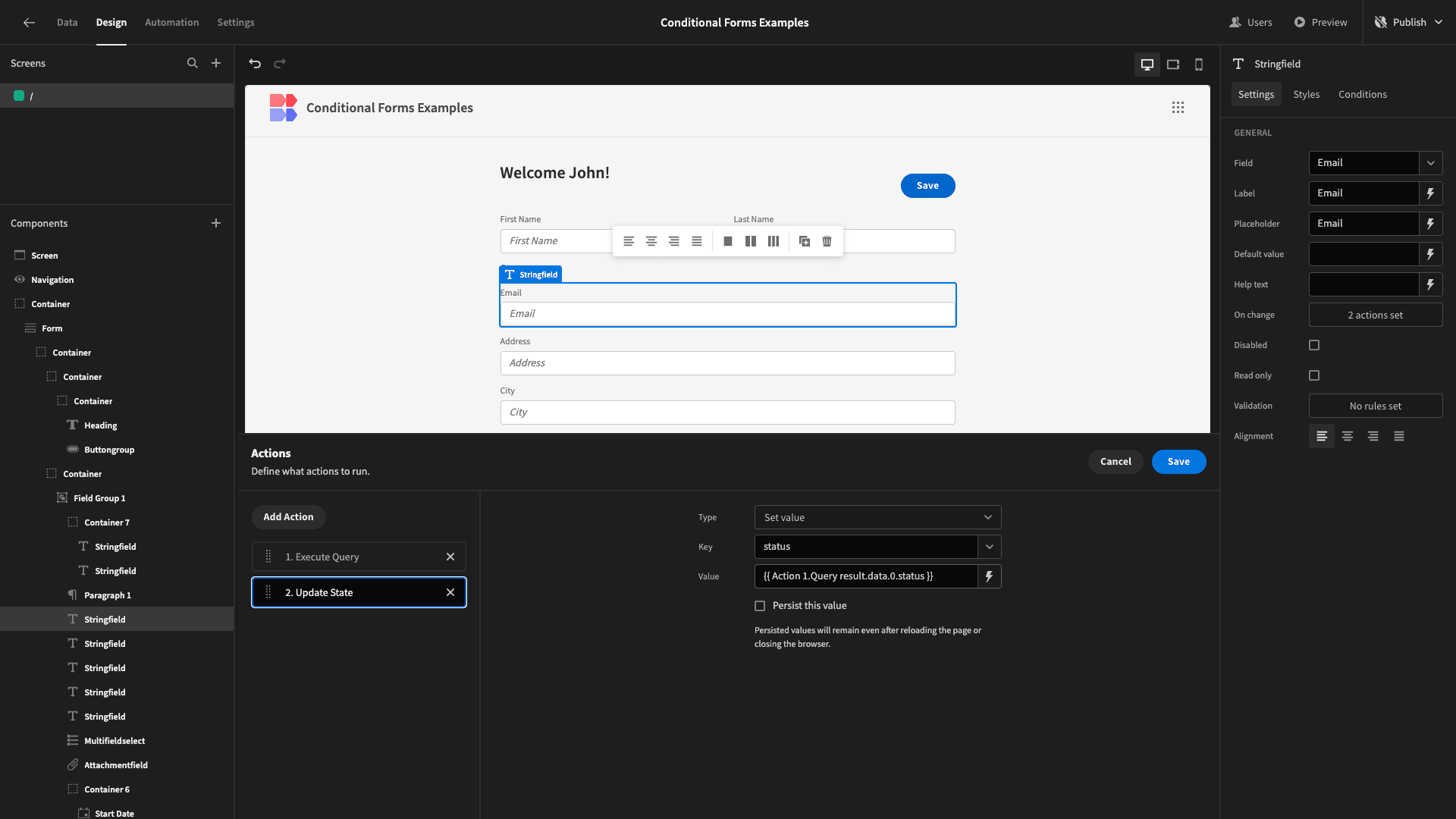
WeŌĆÖve done this with the binding {{ Action 1.Query result.data.0.status }}. So, once an email address has been submitted, our state can either be ŌĆ£validŌĆØ or ŌĆ£invalidŌĆØ.
WeŌĆÖll add an Update Setting condition to our email field, which updates the Help Text:
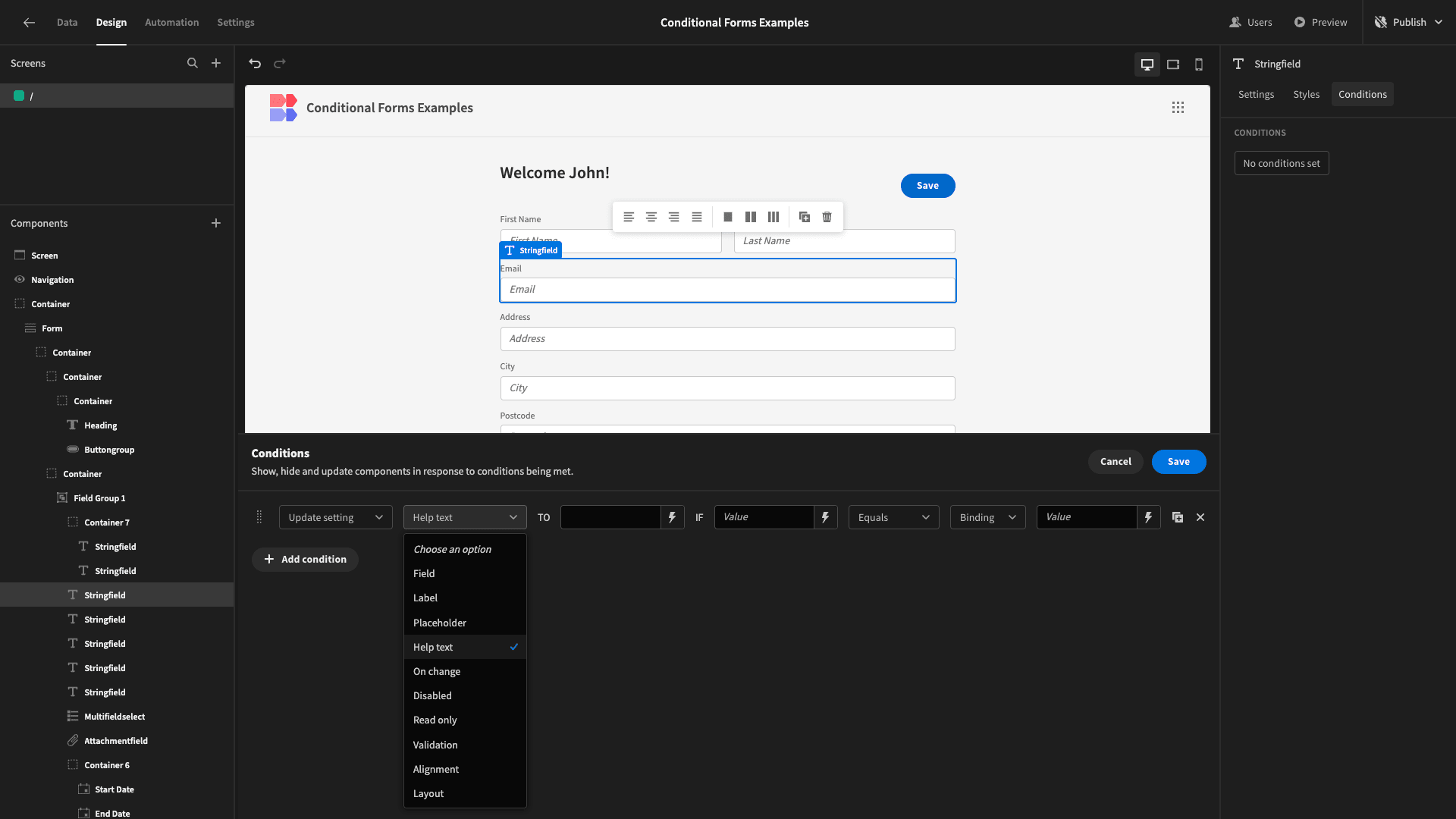
WeŌĆÖll use the ŌĆ£statusŌĆØ attribute under State to set our new Help Text to:
1Email address is {{ State.status }}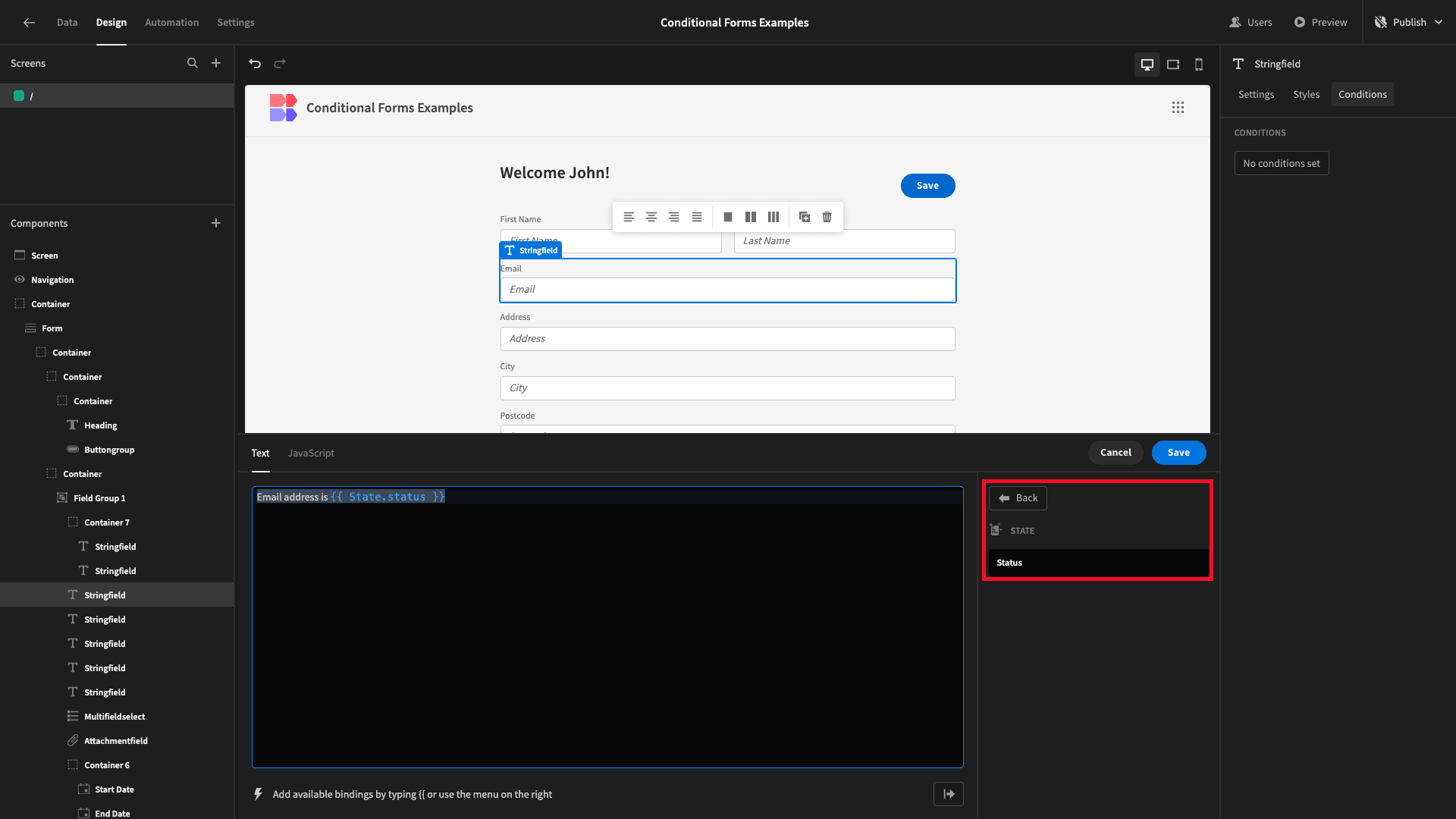
Our comparison value is {{ State.status }} and weŌĆÖre using an Is Not Empty operator:

Now, if we enter an invalid email address, weŌĆÖll see a message that reads, ŌĆ£Email address is invalidŌĆØ.
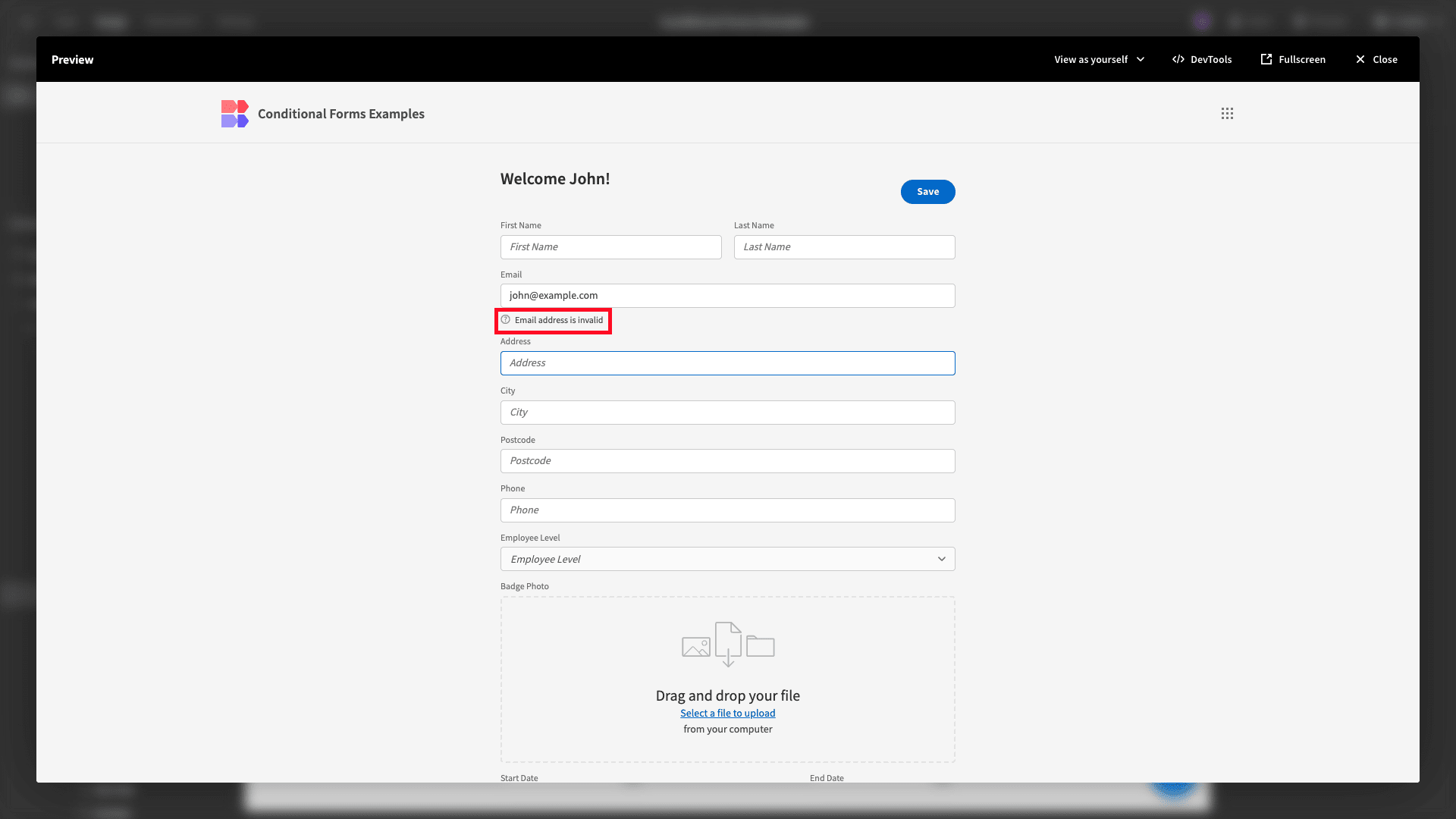
WeŌĆÖll also see a corresponding message if we input a valid email address.
Build advanced forms with ║┌┴Žš²─▄┴┐
║┌┴Žš²─▄┴┐ is the open-source, low-code platform that empowers teams to turn data into action.
Today, weŌĆÖve aimed to show off how our platform can be used to build advanced forms on top of just about any data source. Of course, we canŌĆÖt show every possible use case for conditional logic forms.
Rather, the idea is to demonstrate the unrivaled flexibility ║┌┴Žš²─▄┴┐ offers for building custom solutions at pace.
To learn more, check out our forms page .